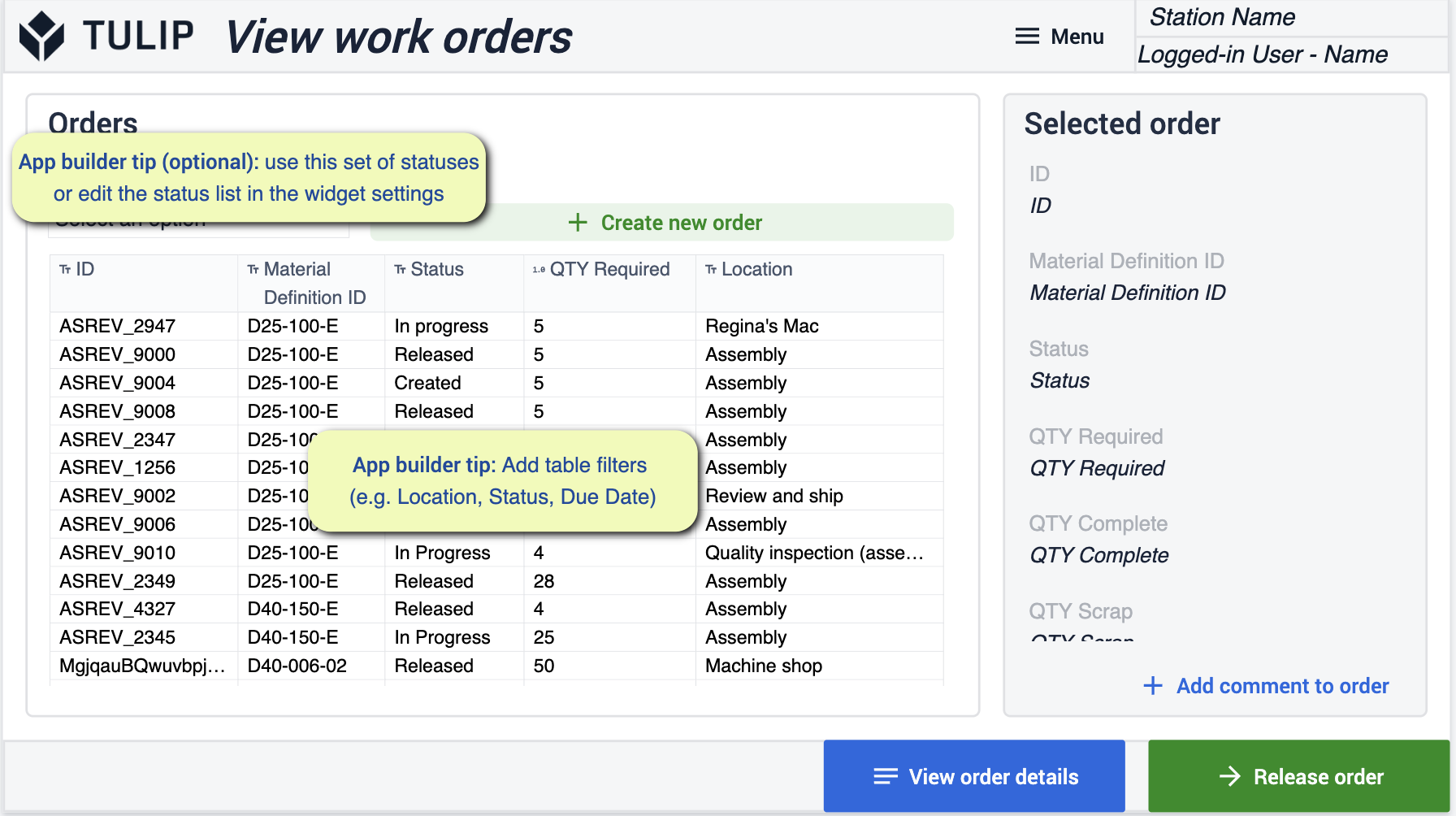::: (info) ()Download this app suite here.:::A Composable MES Suite egyszerű kiindulópontot biztosít a mérnökök számára, akik egy olyan MES-t szeretnének telepíteni, amely a működésük értékteremtésére összpontosít. Ez az App Suite végigvezeti Önt azon, hogyan néz ki az adatok rendszerezése és gyűjtése, miközben megtanítja a legjobb gyakorlatokat az értékteremtéshez a vállalkozásában.
A Production Management alkalmazáscsomag kiindulópontot biztosít a termelési munkafolyamatok kezeléséhez. A termeléssel kapcsolatos részletes betekintés összegyűjtése lehetővé teszi csapata számára, hogy jobb döntéseket hozzon a működés javítása érdekében.
A javítás gyakori területei a pontos szállítás, az állásidő gyökeres okainak elemzése, valamint az OEE holisztikus nyomon követésének képessége (berendezések, emberek, anyagáramlás stb.).
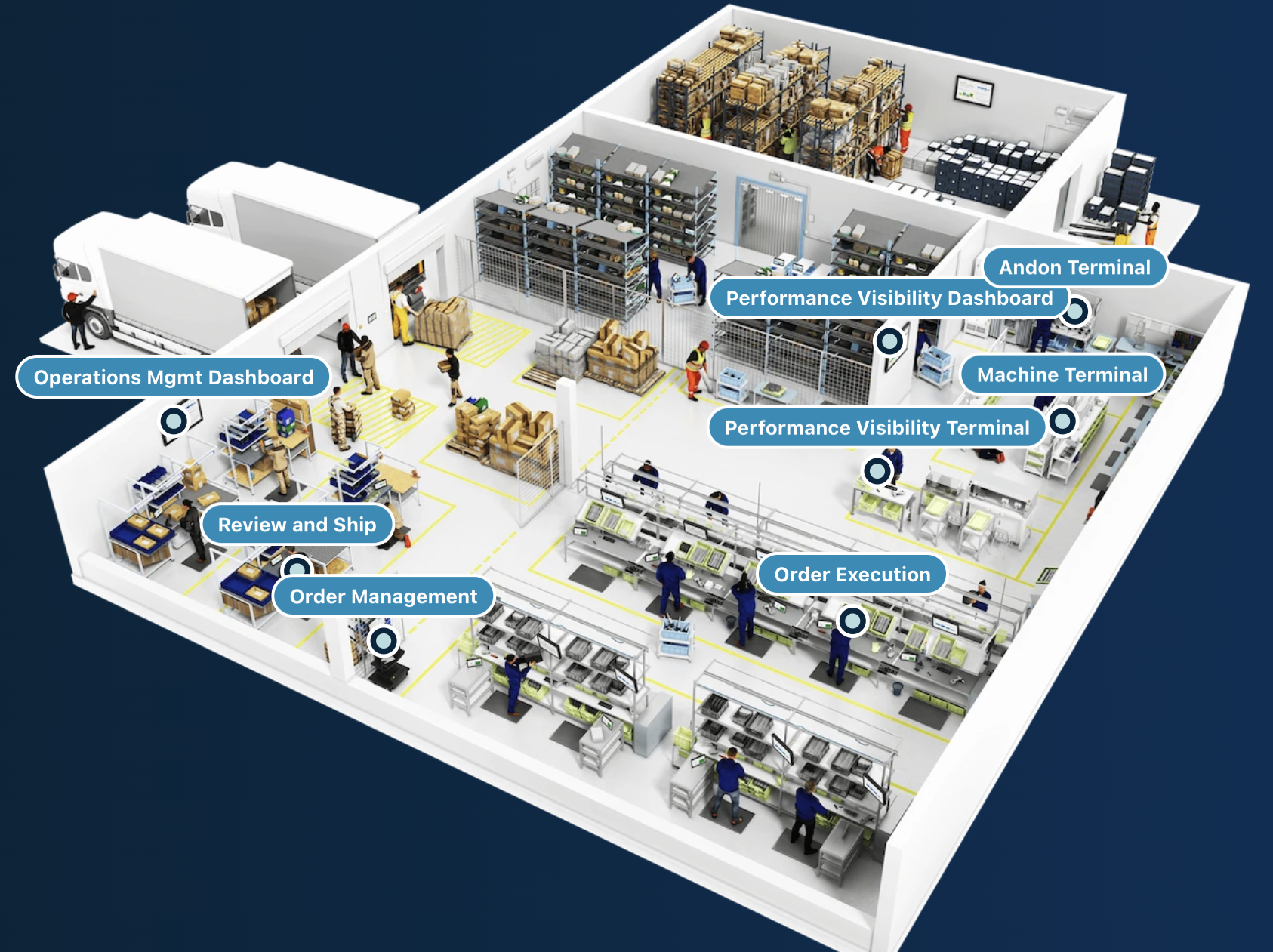
Előfeltételek
Ebben az alkalmazáscsomagban számos App Builder tippet kell követni. 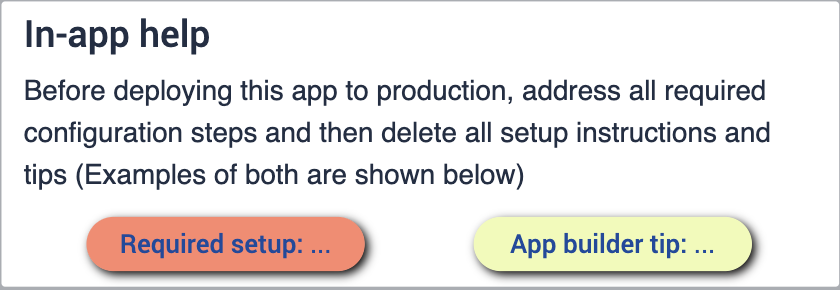
Mielőtt konfigurálhatná az alkalmazáscsomagot, győződjön meg arról, hogy ismeri a következő készségeket:
- Alapvető alkalmazásépítési ismeretek
- Tulip táblák (beleértve a mezők szerkesztését, a szűrők használatát és a rekordhelyettesítőket)
Telepítés
Meg kell győződnie arról, hogy megfelelően érti, hogyan telepítse ezeket az alkalmazásokat a kívánt eszközökre, és hogyan futtassa őket egy állomáson. Fontos, hogy megértse az üzletmenetét. Ha van egy diagramja az üzlethelyiségéről, akkor jobban megértheti, hogy hol szeretné, hogy az alkalmazások éljenek a folyamat során.
Összekapcsolt asztalok
A táblázatokat, amelyeket ebben az alkalmazáscsomagban használni fog, a különböző alkalmazásokban fogja használni és összekapcsolni. Ez lehetővé teszi a könnyebb felhasználói élményt, valamint a táblázatok hálózatát, amelyet a jövőbeli alkalmazások fejlesztésekor használhat. Tudjon meg többet arról, hogy a táblázatok hogyan minimalizálják a redundanciát és maximalizálják a kompatibilitást a közös adatmodell használatával.
Ismerkedjen meg a cMES-ben használt közös tulipán táblákkal.
Letöltés
Kattintson a termelésirányítási alkalmazáscsomag linkjére. Ez a könyvtár oldalára vezet, ahol hozzáadhatja az alkalmazást a példányához. 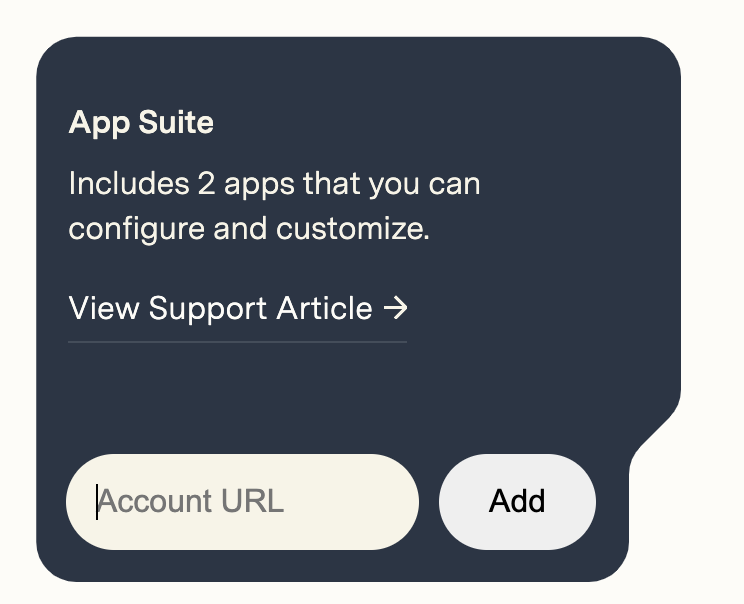
Az App Suite hozzáadása után a példányában talál egy Production Management nevű mappát, amely a csomagban található összes alkalmazást tartalmazza.
Alkalmazások konfigurálása
:::(Info) (NOTE)While configuring applications, any changes made to tables need to be made across all applications for connectivity.:::
Andon Management
Az Andon alkalmazás gyors és egyszerű módot biztosít a problémák jelzésére az emeleten. Amikor egy problémát jelez, a figyelmeztetések valós időben értesítik a probléma megoldásához szükséges személyeket, hogy a lehető leghamarabb intézkedhessenek.
Állomásállapot-térkép
Az alkalmazás első megnyitásakor észreveheti az "Alkalmazáskészítő tippeket", amelyek útmutatást adnak a felhasználóknak az alkalmazás üzemi szintre történő konfigurálásához. Az alkalmazásnak ez a lépcsőfoka a műveletek állapotának vizuális megjelenítése az egész üzemi szinten.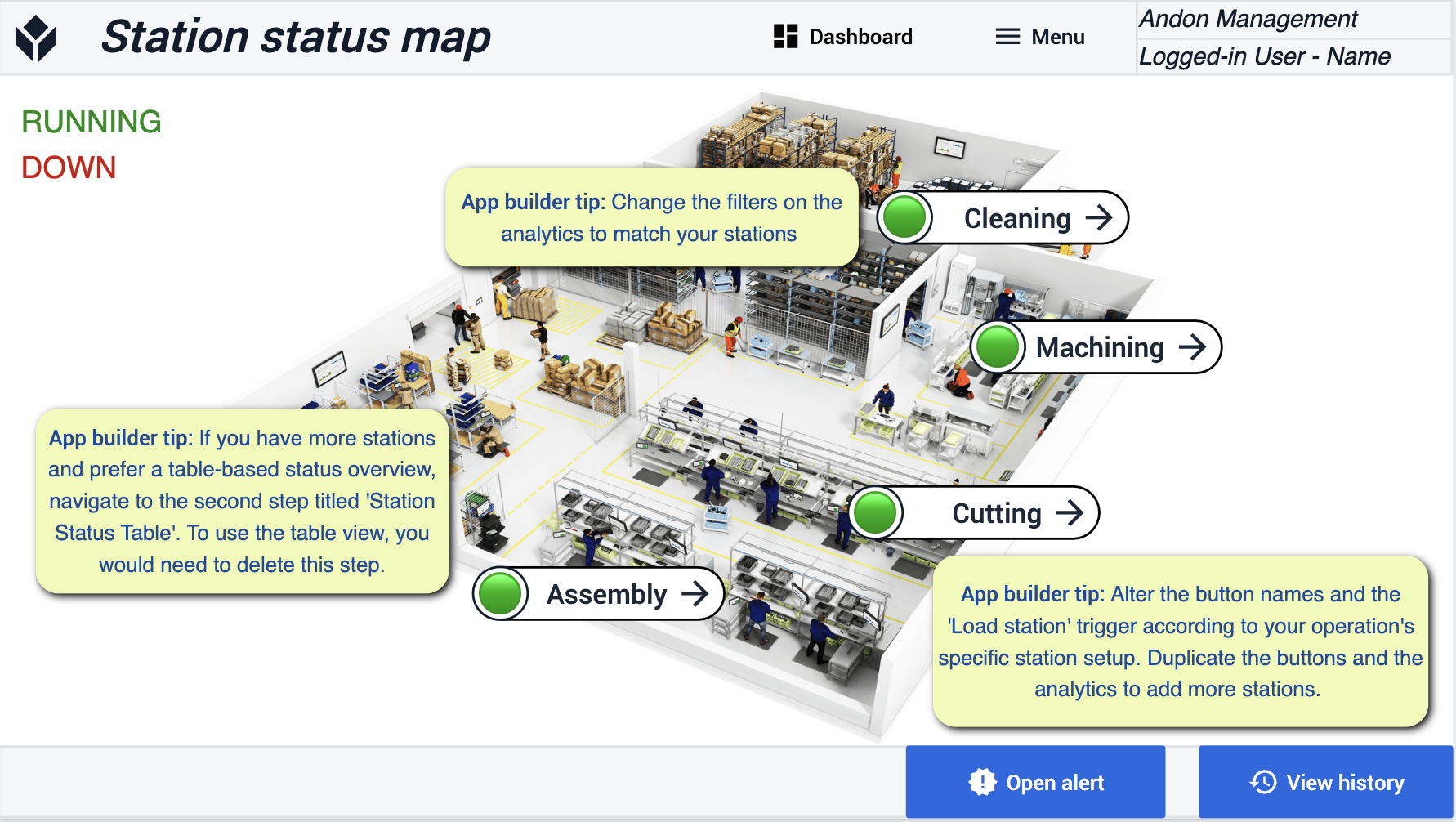
Állomásállapot-táblázat
Ennek a lépésnek az itt való megjelenése opcionális. Ha a térkép helyett inkább egy táblázatos áttekintést szeretne, akkor a térképet eltávolíthatja.
Állomás részletek-előrejelzések megtekintése
Az üzemi területről jelzett konkrét események megtekintése. Ezeket az eseményeket különböző felhasználókhoz rendelheti, vagy maga oldhatja meg. Azt is láthatja, hogy honnan származik ez az esemény.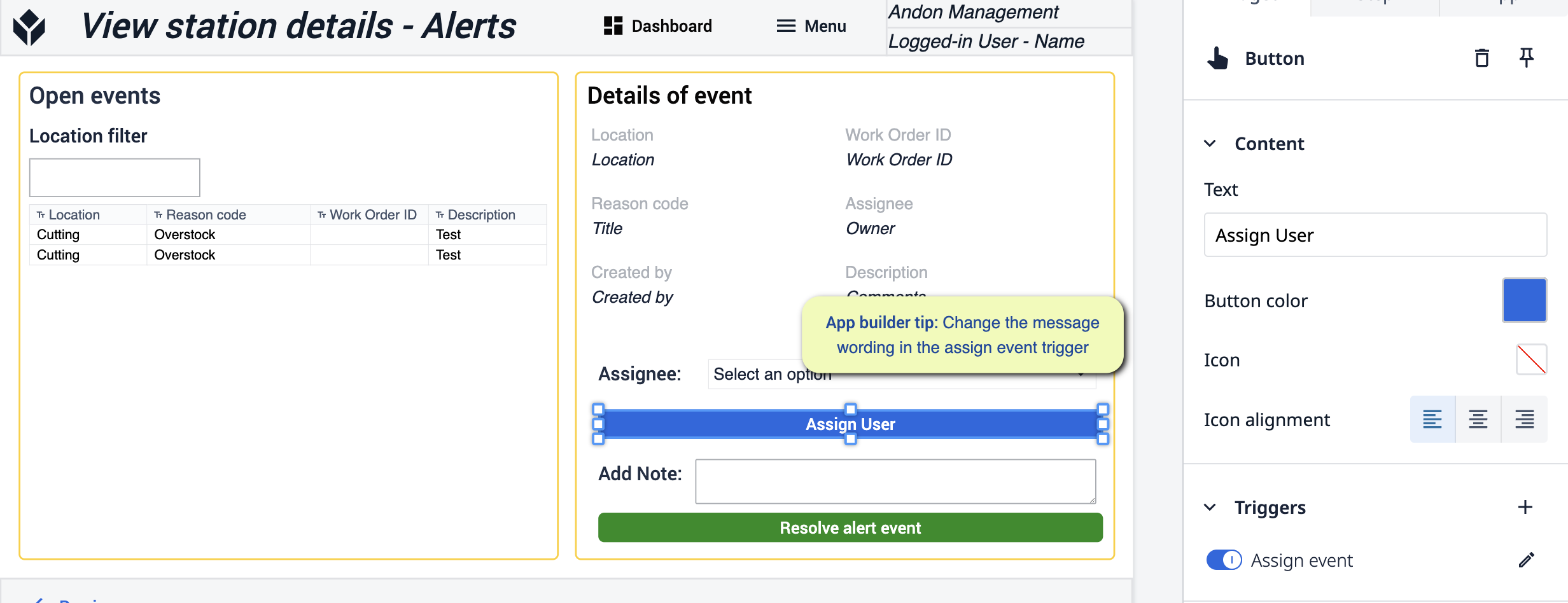 {height="300" width=""}* Ebben a lépésben a "Felhasználó hozzárendelése" gomb kiváltójának módosítását végzi el. Az üzenetküldést a saját igényeinek megfelelően alakítsa ki.
{height="300" width=""}* Ebben a lépésben a "Felhasználó hozzárendelése" gomb kiváltójának módosítását végzi el. Az üzenetküldést a saját igényeinek megfelelően alakítsa ki.
Andon
Az alkalmazás Andon verziójának használata esetén ugyanezeket a változtatásokat fogja elvégezni, amikor a kiváltó nyelvének hozzárendelésével a folyamathoz igazítja a váltó nyelvet.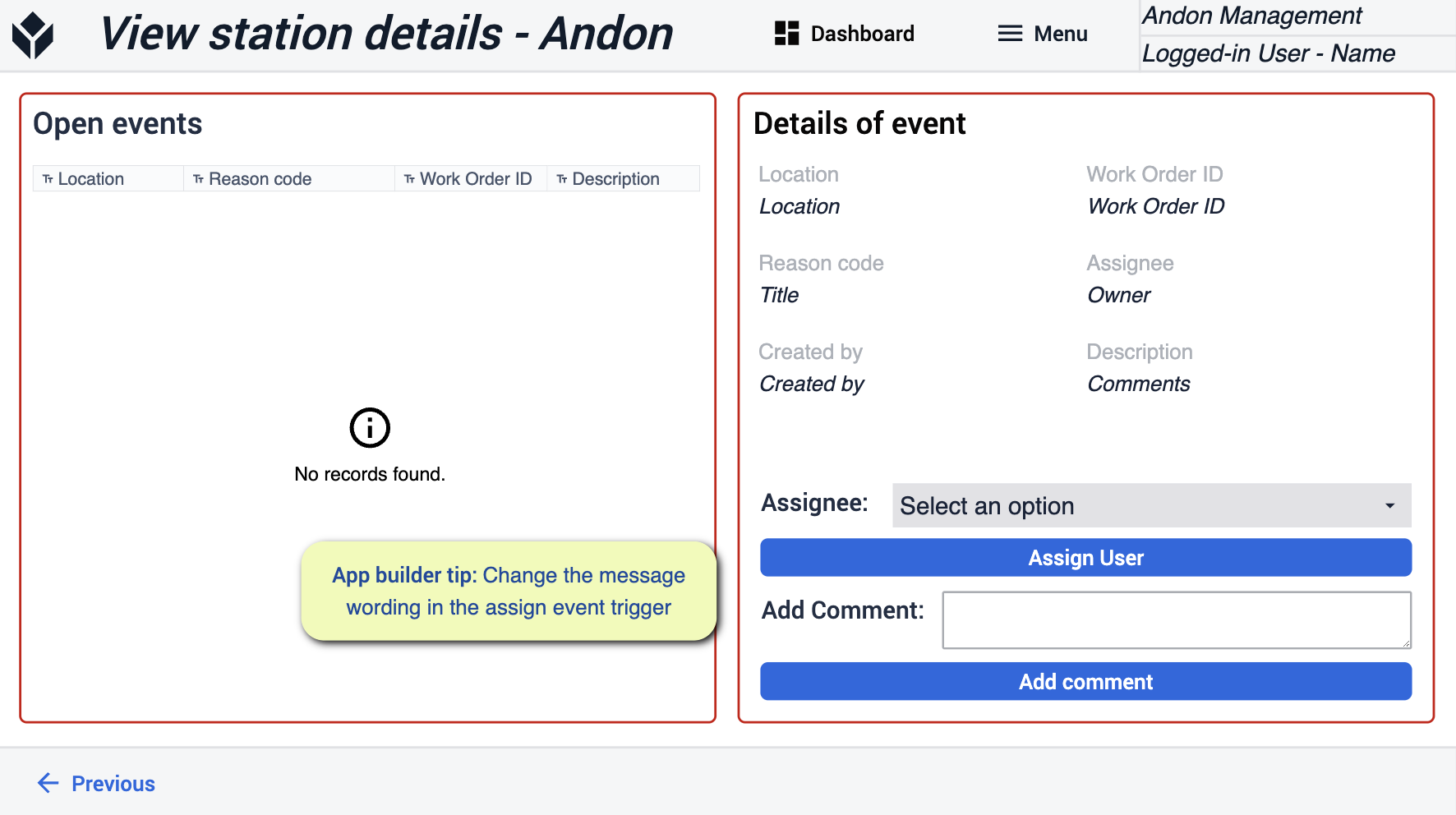
Előzmények megtekintése
Az alkalmazás során naplózott események megtekintése. Részletesebb betekintést nyerhet a történésekbe.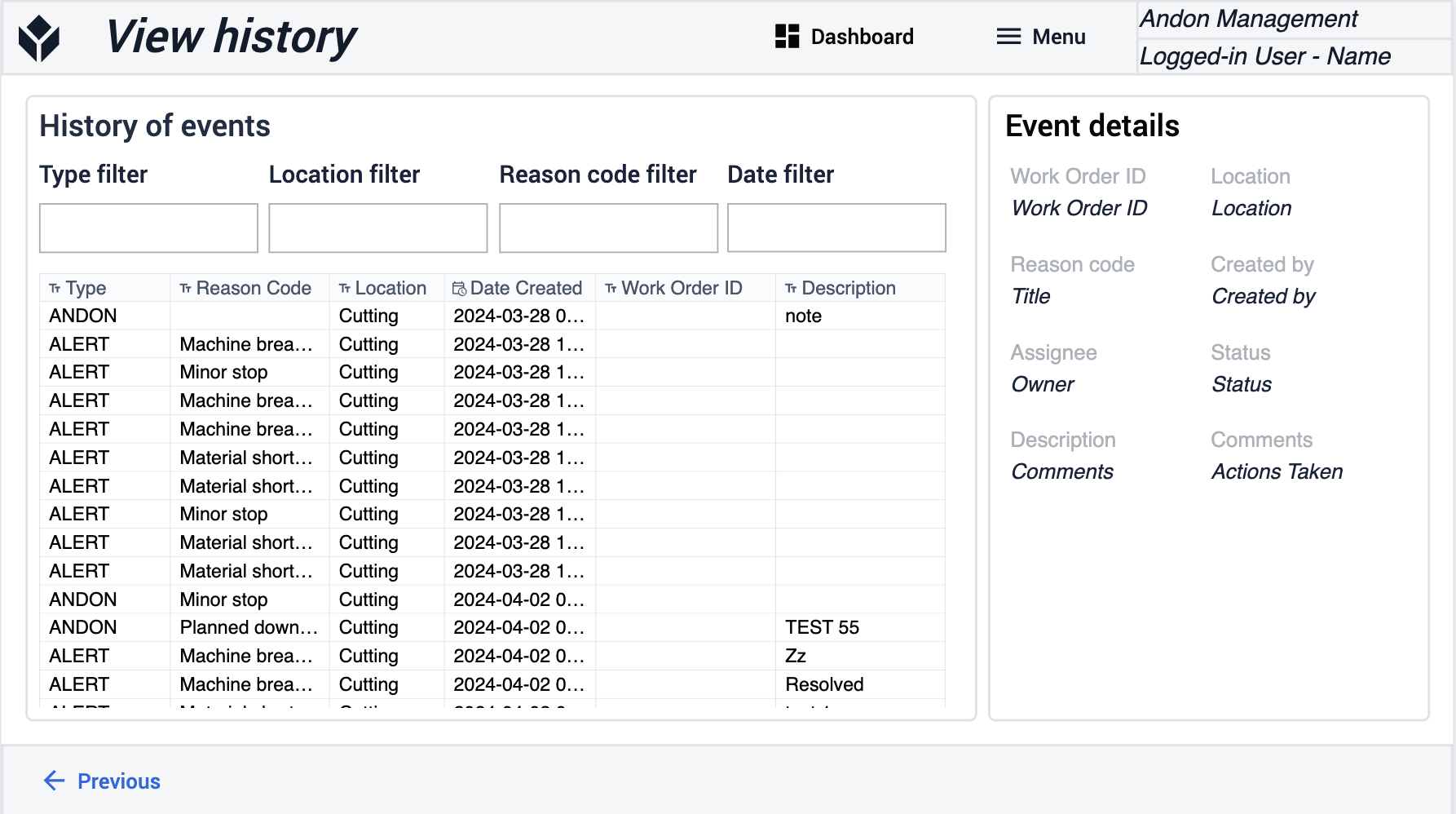
Dashboard
Ez a nézet arra szolgál, hogy láthassa az eddig mindkét kategóriában történt riasztások számát, és megértse az eseményekre fordított időt.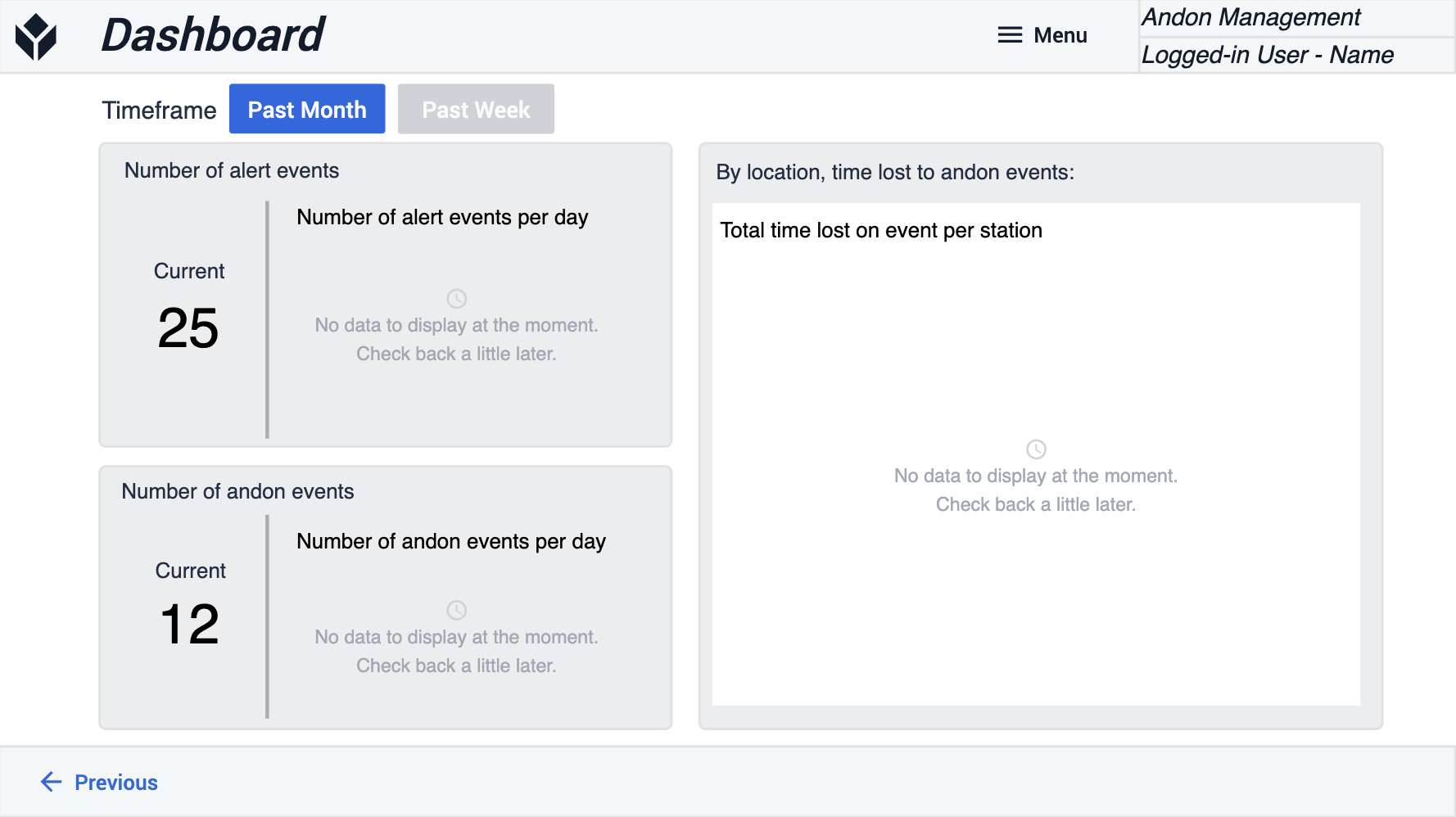
Gépfelügyeleti terminál
Ez a Machine Monitoring Terminal alkalmazás a gépek kihasználtságának és teljesítményének nyomon követésére készült. Lehetőséget ad az üzemeltetőknek, hogy több kontextust adjanak hozzá az állásidők jelentéséhez, a termelési arányok naplózásához és a gyártott alkatrészek részleteihez. A felügyelők számára egyértelmű áttekintést nyújt az OEE-t körülvevő kulcsfontosságú mérőszámokról.
Válassza ki a megrendelést
Ezen a lépcsőn láthatja és kiválaszthatja a termeléshez indítandó munkarendeket.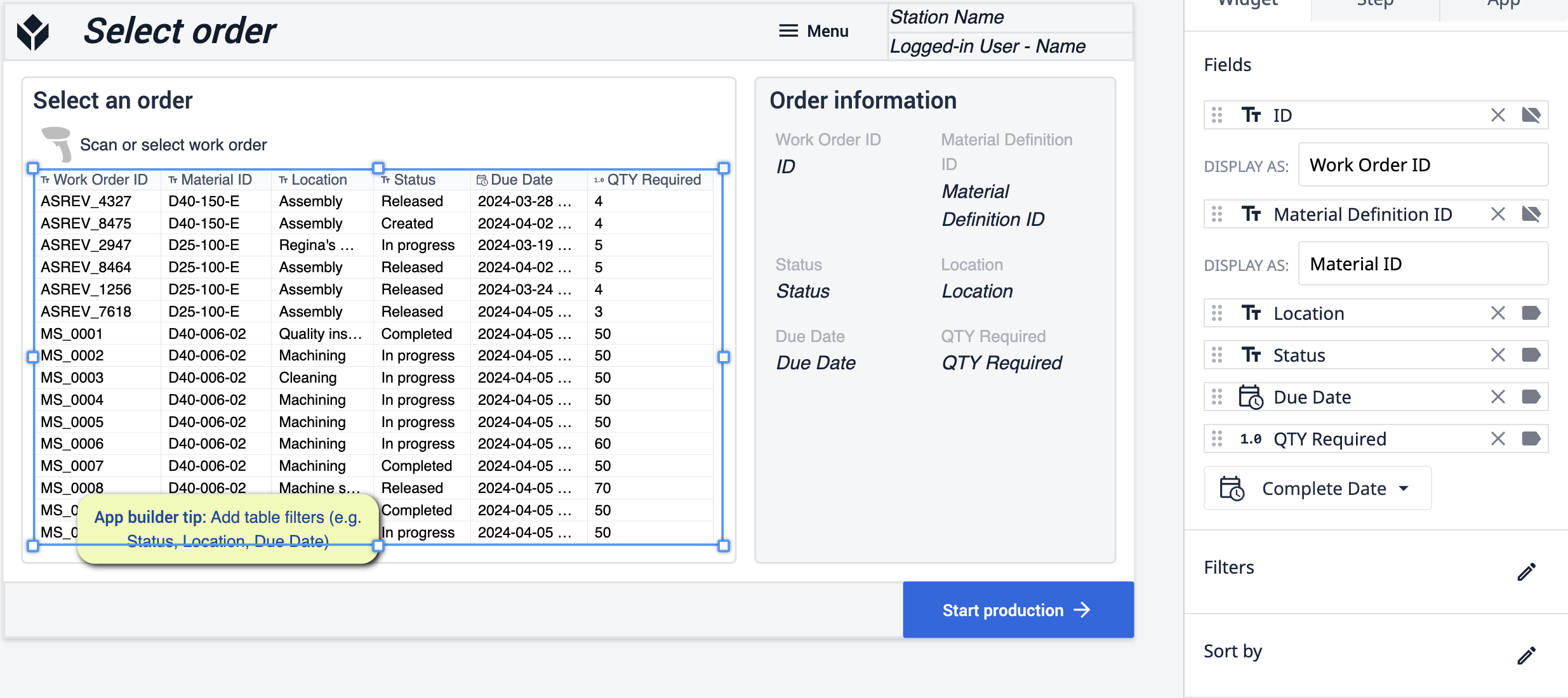 {height="300" width=""}* Az alkalmazás ezen lépcsőjén szükség szerint módosíthatja a táblázatot. szűrőket adhat hozzá a nyomon követendő mezők alapján. Ügyeljen arra, hogy a táblázatra kattintva ellenőrizze, hogy az a beállításokkal frissült-e.
{height="300" width=""}* Az alkalmazás ezen lépcsőjén szükség szerint módosíthatja a táblázatot. szűrőket adhat hozzá a nyomon követendő mezők alapján. Ügyeljen arra, hogy a táblázatra kattintva ellenőrizze, hogy az a beállításokkal frissült-e.
Gépi terminál
Itt láthatja a kiválasztott gépek üzemidejét és állásidejét. A teljesítményt a gyártott alkatrészeken és a nyomon követett hibákon keresztül követheti nyomon.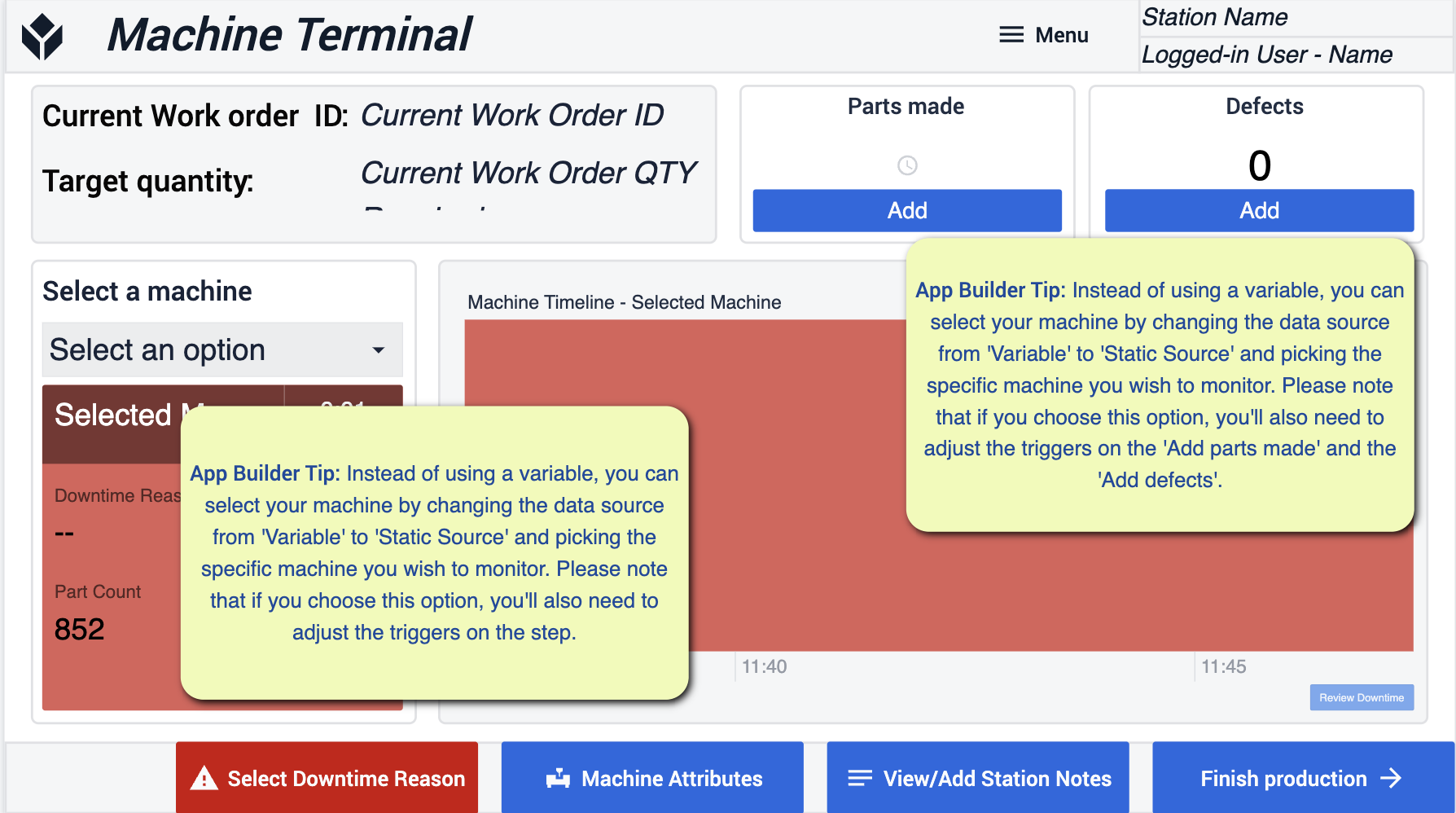 {height="300" width=""}* Kövesse az App Builder tippjeit, hogyan szeretné konfigurálni a gépeit. Koncentráljunk arra, hogy a gépeket előre elkészített Változókon keresztül tudjuk összekapcsolni.
{height="300" width=""}* Kövesse az App Builder tippjeit, hogyan szeretné konfigurálni a gépeit. Koncentráljunk arra, hogy a gépeket előre elkészített Változókon keresztül tudjuk összekapcsolni.
Válassza ki a leállás okát
Ha egy gép leállt, válasszon egy okot, amiért az adott gép leállt, hogy jobban betekintést nyerjen a teljesítménybe és az alkalmazás más lépéseinek láthatóságába.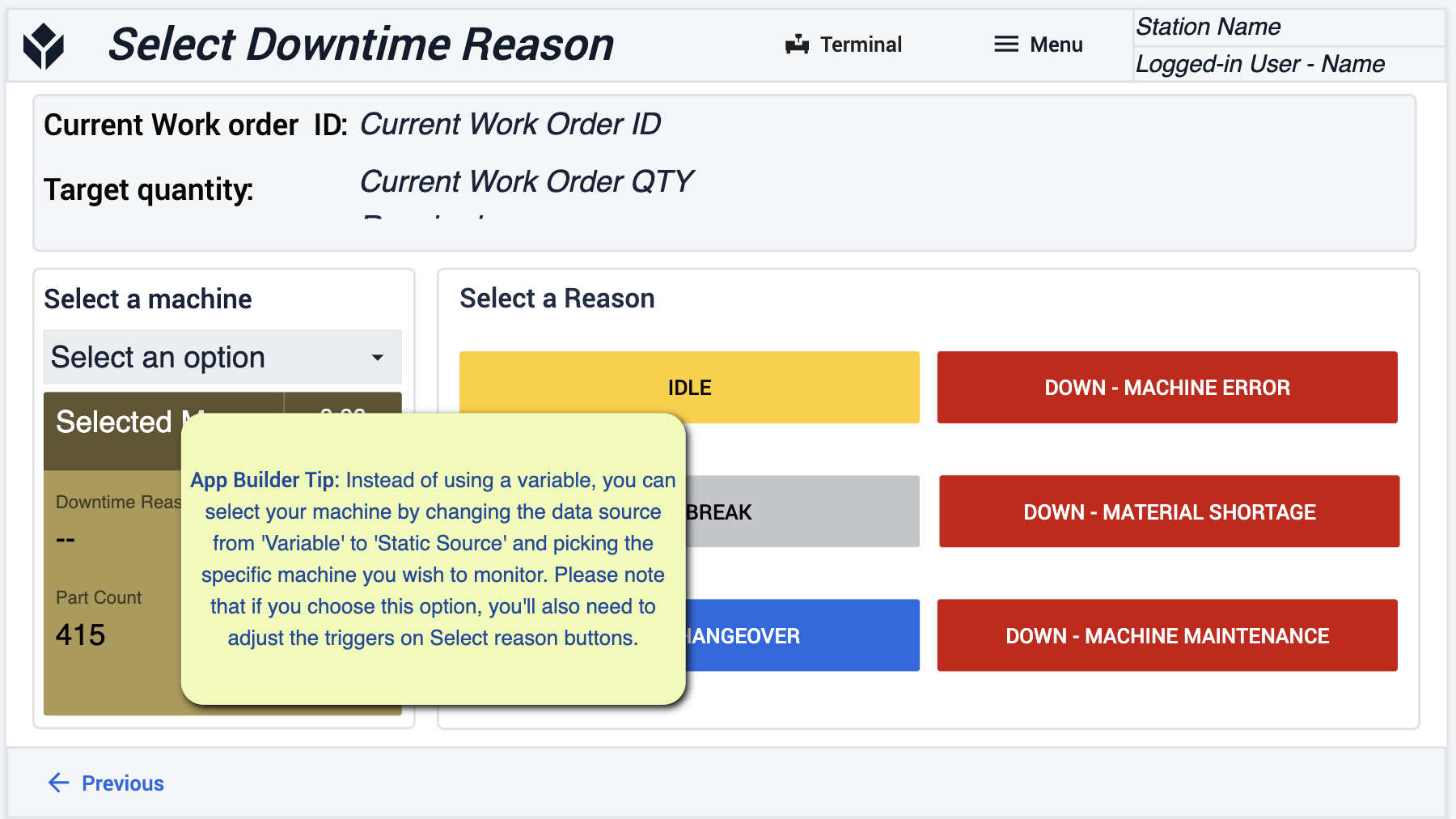 {height="300" width=""}* Az itt végrehajtott változtatásoknak ugyanabban a formátumban kell lenniük, mint a gép adatforrásában végrehajtott egyéb változtatásoknak.
{height="300" width=""}* Az itt végrehajtott változtatásoknak ugyanabban a formátumban kell lenniük, mint a gép adatforrásában végrehajtott egyéb változtatásoknak.
Analitika
Itt láthatja a napi mérőszámait, és gyorsan áttekintheti az általános teljesítményt. Ezeknek a mérőszámoknak a nyomon követése fontos a döntések meghozatalához.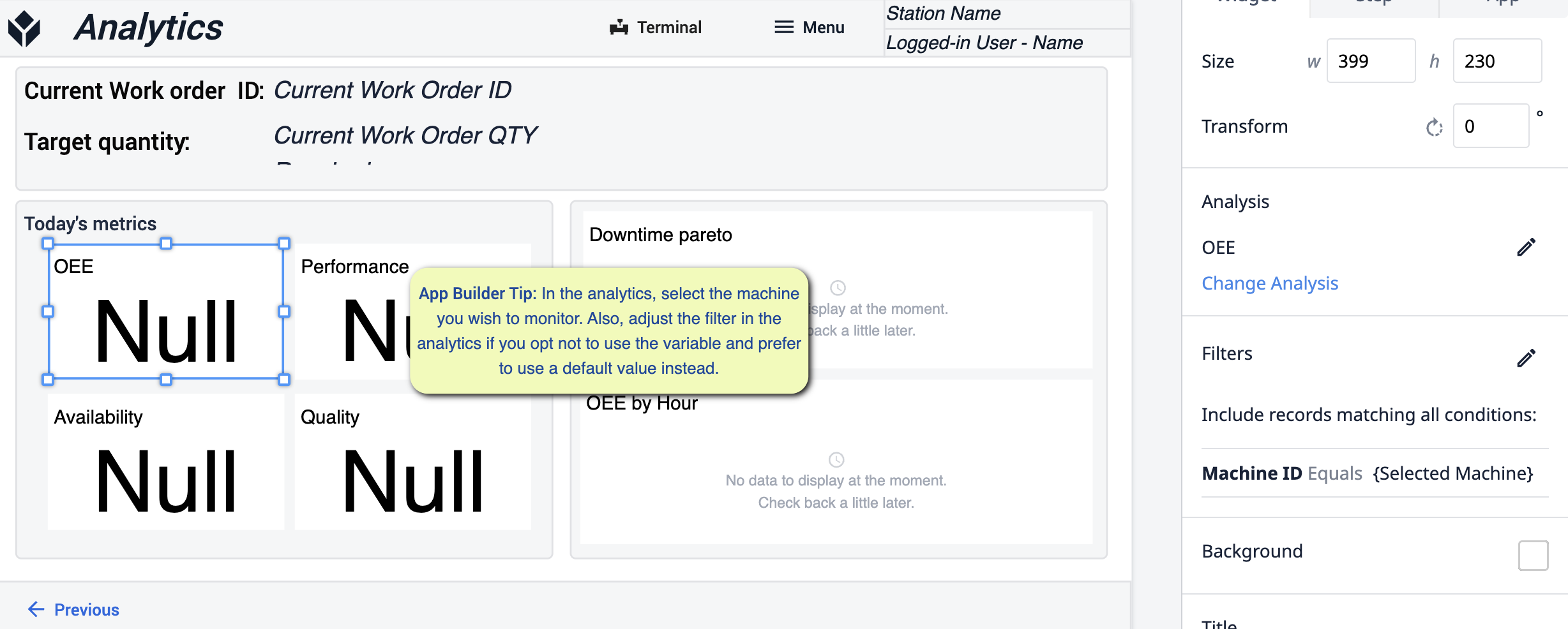 {height="300" width=""}* Ezen a lépcsőn részletesebb elemzést kap a gép teljesítményéről gépenként. . Az elemzési szűrők segítségével határozza meg, hogy melyik gép(ek)ről szeretne betekintést nyerni.
{height="300" width=""}* Ezen a lépcsőn részletesebb elemzést kap a gép teljesítményéről gépenként. . Az elemzési szűrők segítségével határozza meg, hogy melyik gép(ek)ről szeretne betekintést nyerni.
Attribútumok
Ebben a szakaszban kiválaszt egy gépet, hogy jobban megértse az állásidő okát. 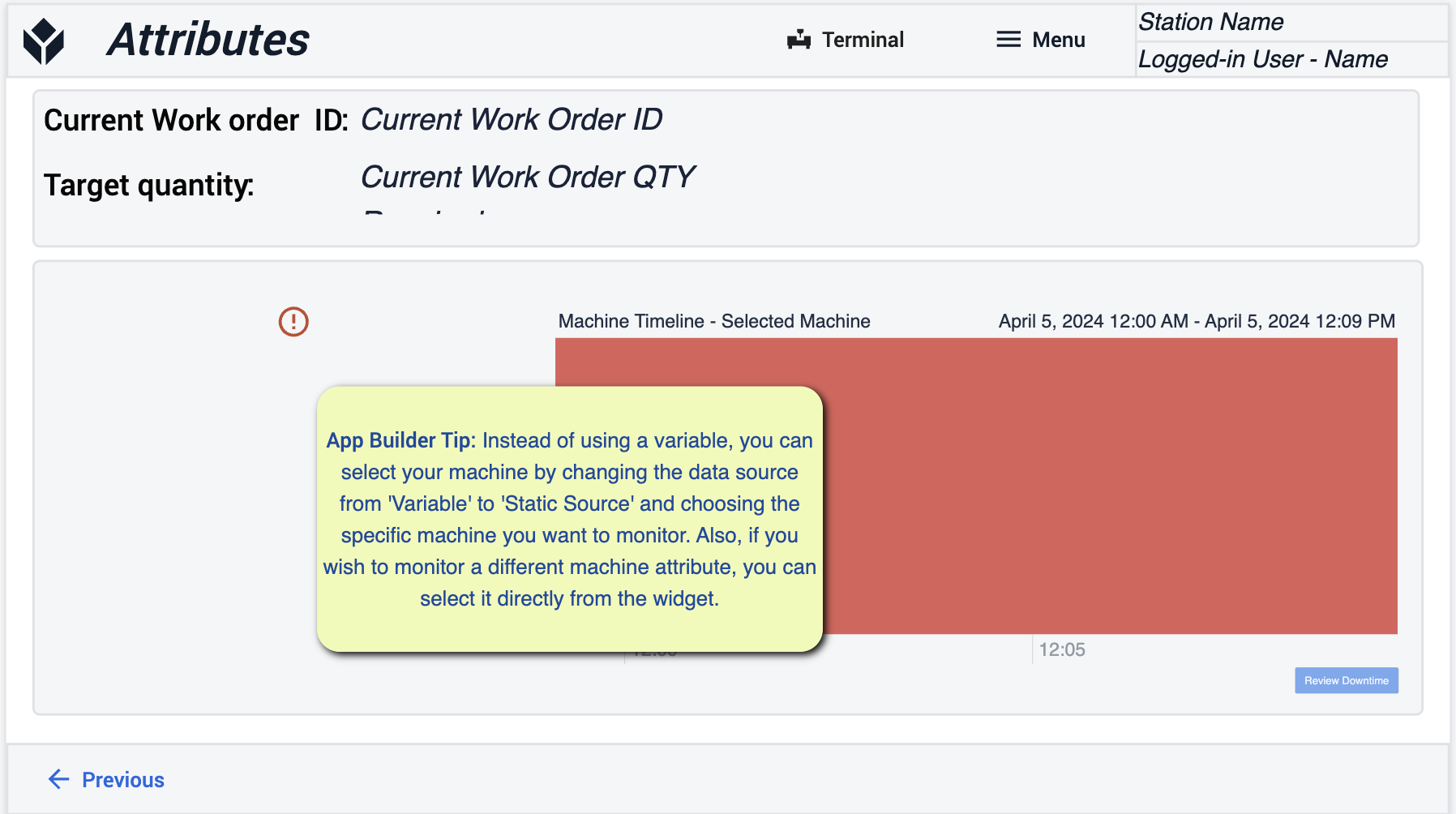 {height="300" width=""}* Az állásidő okait Ön fogja beállítani, és ehhez a lépéshez ugyanazokat az alkalmazáskészítő tippeket kell követnie a gépi adatforrás feltöltéséhez.
{height="300" width=""}* Az állásidő okait Ön fogja beállítani, és ehhez a lépéshez ugyanazokat az alkalmazáskészítő tippeket kell követnie a gépi adatforrás feltöltéséhez.
Állomásjegyzetek megtekintése/hozzáadása
Megnézheti a más operátorok meglévő jegyzeteit a gépi tevékenységhez, és hozzáadhatja saját jegyzeteit. Egyértelmű betekintést nyújt az adott gép előzményeibe.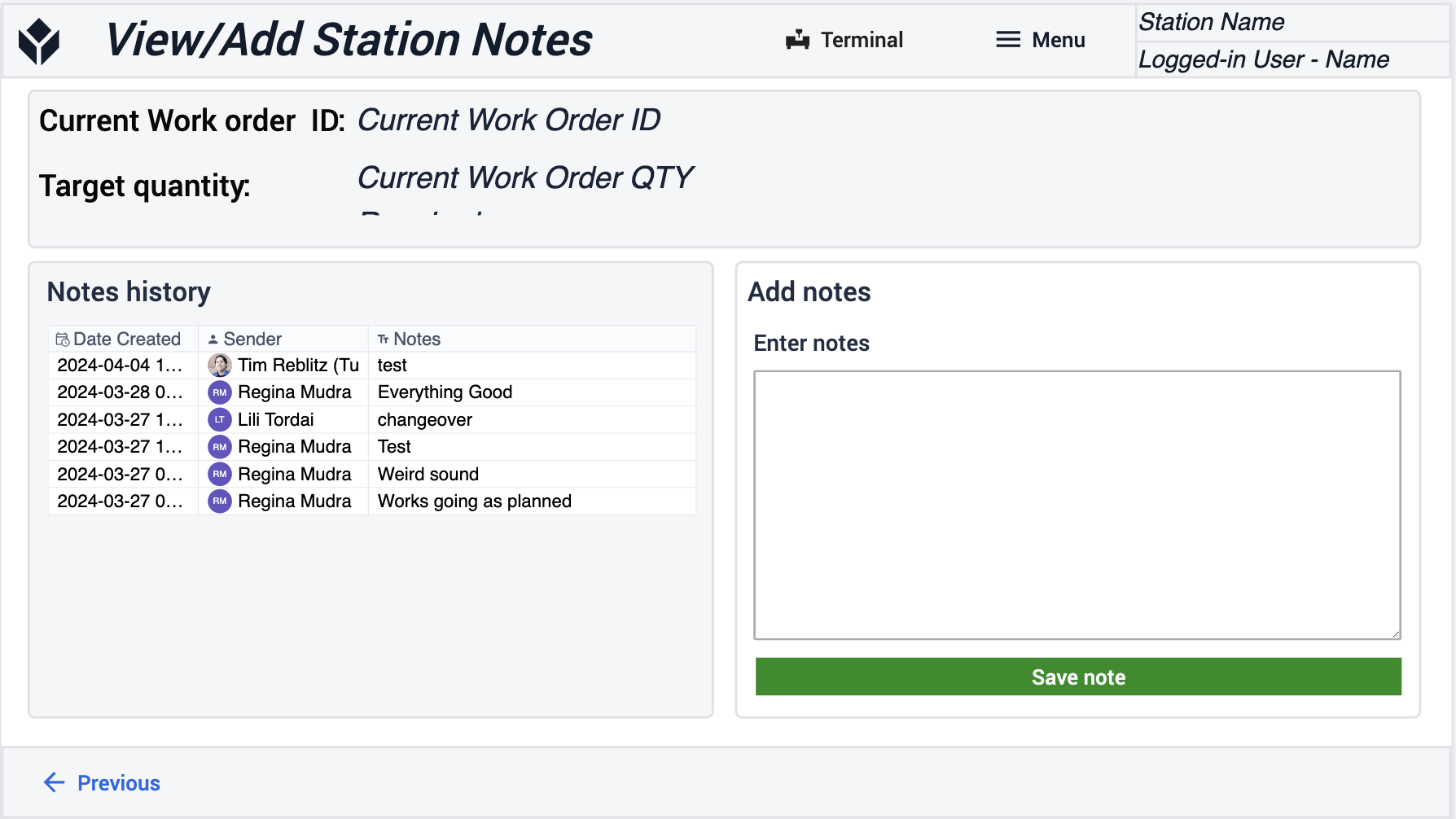
Megbízás végrehajtása
Ebben az alkalmazásban teljes rálátása lesz az összes munkamegbízás állapotára a Létrehozott, Folyamatban lévő, Befejezett és Felszabadított állapotok közül. Nemcsak a műveletek körét láthatja, hanem a megbízások életciklusának bármely szakaszában képes visszavezetni azokat.
Felszabadított munkamegrendelések megtekintése
Ebben a lépésben láthatja először a rendelkezésére álló vagy már befejezett munkamegrendeléseket.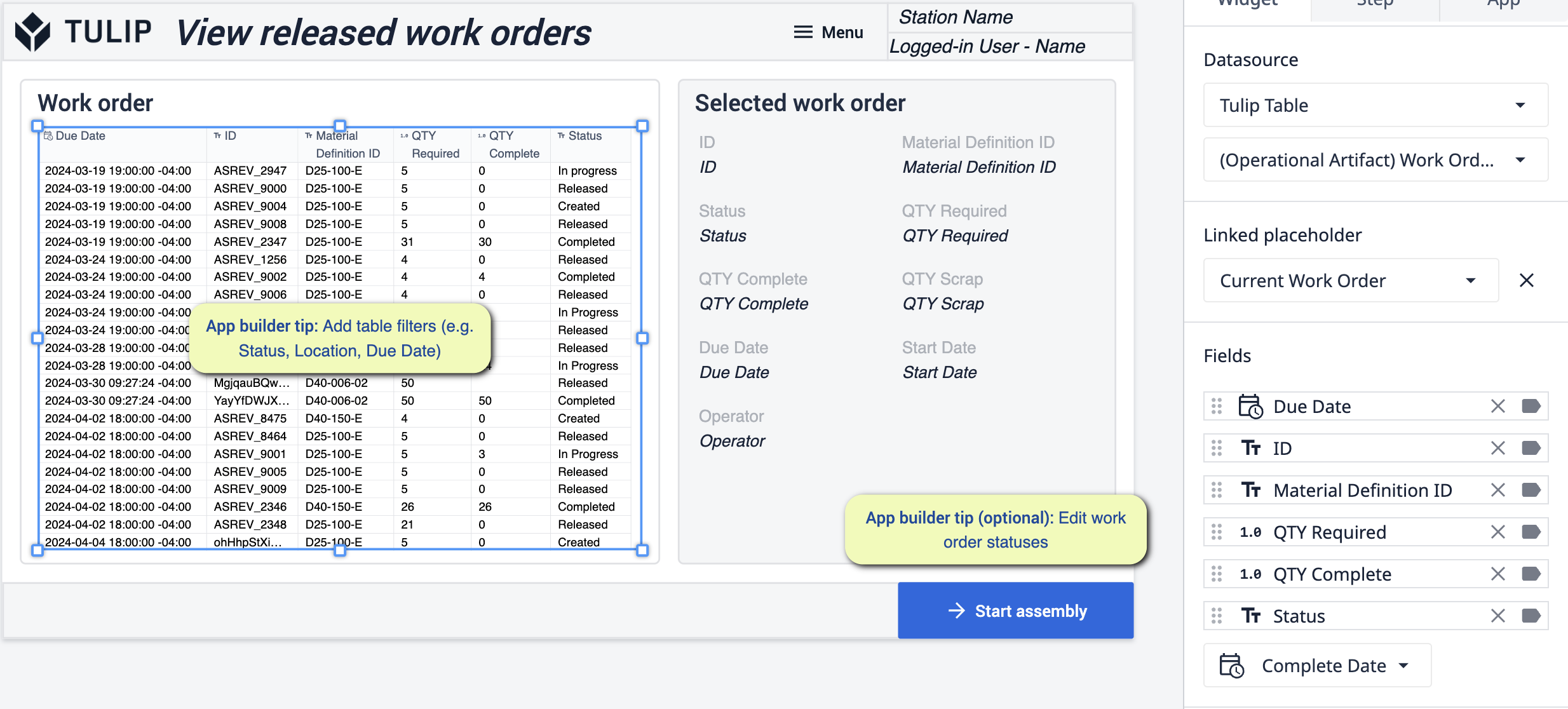 {height="300" width=""}* Ebben a lépésben láthatja az összes nyomon követett munkamegrendelést. Az ebben a lépésben elvégezhető módosítások a táblázat szűrők hozzáadására és a mezők szerkesztésére összpontosítanak. Egy opcionális lépés itt a munkamegrendelések állapotának szerkesztése lenne.
{height="300" width=""}* Ebben a lépésben láthatja az összes nyomon követett munkamegrendelést. Az ebben a lépésben elvégezhető módosítások a táblázat szűrők hozzáadására és a mezők szerkesztésére összpontosítanak. Egy opcionális lépés itt a munkamegrendelések állapotának szerkesztése lenne.
Folyamatban lévő munkamegrendelés
Ezen a lépésen követi az utasításokat a korábban kiválasztott munkamegrendelés befejezéséhez. Az idő előrehaladtával módosíthatja, hogy a megrendelés mekkora része készül el.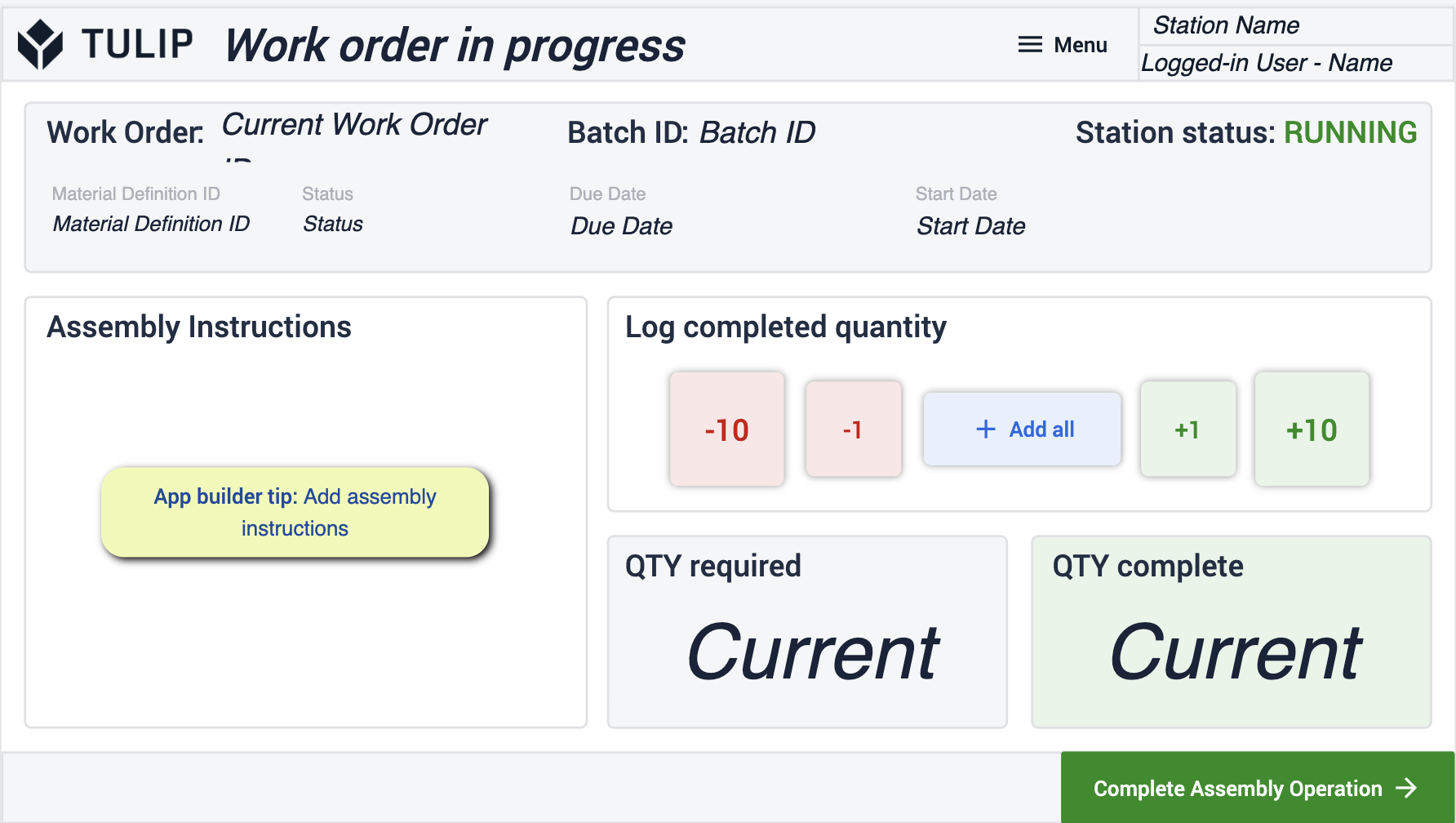 {height="300" width=""}* Itt kezdheti el a munkamegrendelés előrehaladásának naplózását, amelyen éppen dolgozik. Ennek a lépésnek a konfigurációja az összeszerelési utasítások hozzáadása. Ez történhet részletes szöveges utasítások, CAD-fájlok, videók stb. formájában.
{height="300" width=""}* Itt kezdheti el a munkamegrendelés előrehaladásának naplózását, amelyen éppen dolgozik. Ennek a lépésnek a konfigurációja az összeszerelési utasítások hozzáadása. Ez történhet részletes szöveges utasítások, CAD-fájlok, videók stb. formájában.
Megerősítés befejezése
Itt lesz képes kinyomtatni a címkét a befejezett munkához, ez biztosítja, hogy a megrendelés mindig nyomon követhető legyen, ha szükséges, mivel a történelem még mindig Önnél él . 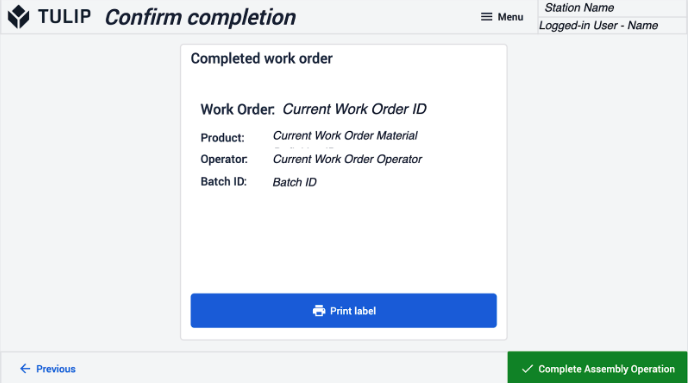
Címke
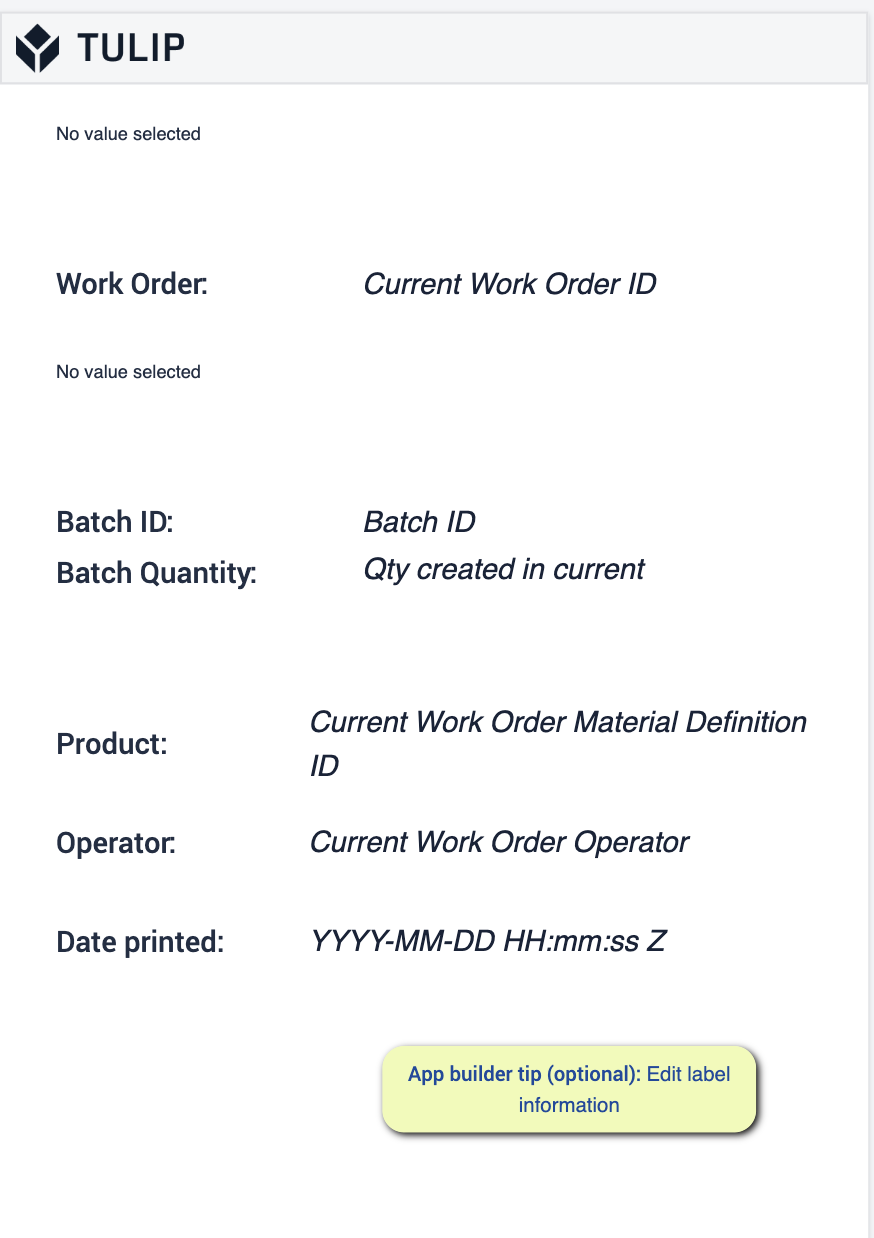 {height="250" width="200"}* Így fog kinézni a címke, és egy opcionális lépés itt, hogy szerkesztheti a címkén megjelenő információkat.
{height="250" width="200"}* Így fog kinézni a címke, és egy opcionális lépés itt, hogy szerkesztheti a címkén megjelenő információkat.
Megrendelés kezelése
Ennek az alkalmazásnak a használata a megrendelések létrehozására és nyomon követésére összpontosít a gyártás során. Teljes rálátása és ellenőrzése van az elvégzett munkákra.
Munkamegrendelések megtekintése
Ezen a lépcsőn megtekintheti a munkamegrendeléseket, és további betekintést nyerhet a látni kívánt megrendelések kiválasztásával.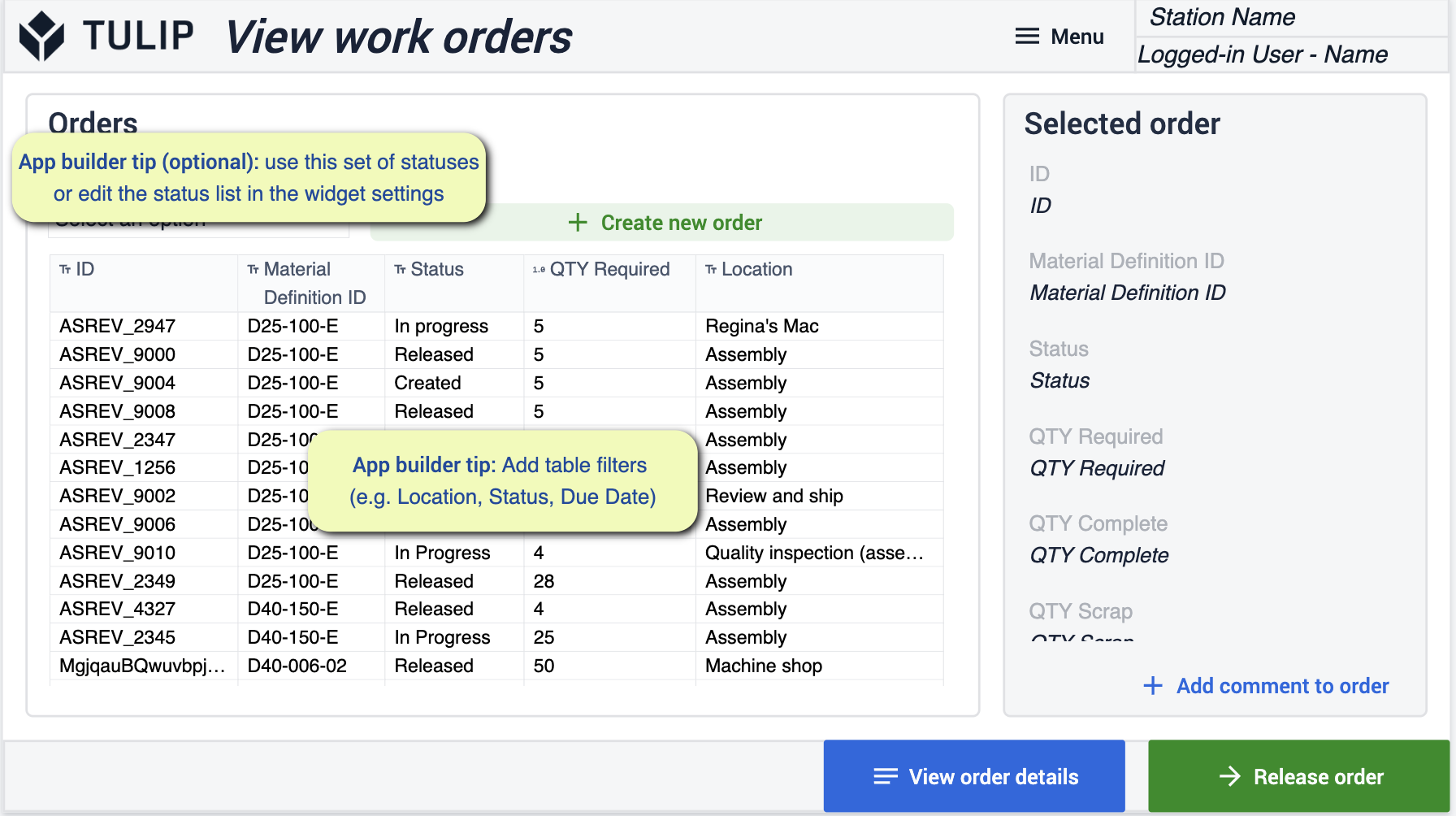 {height="" width=""}* Változtasson a táblázat és a mezők igényeinek megfelelő szűrésével. Opcionális feladatként bátran változtassa meg a használt státuszokat, hogy azok megfeleljenek az Ön üzleti igényeinek.
{height="" width=""}* Változtasson a táblázat és a mezők igényeinek megfelelő szűrésével. Opcionális feladatként bátran változtassa meg a használt státuszokat, hogy azok megfeleljenek az Ön üzleti igényeinek.
Munkamegrendelések létrehozása
Ez a lépés lehetőséget ad arra, hogy szükség szerint manuálisan hozzon létre munkamegrendeléseket. Ezeket a megrendeléseket közvetlenül a termeléshez adhatja hozzá, hogy az operátorok hozzáférhessenek.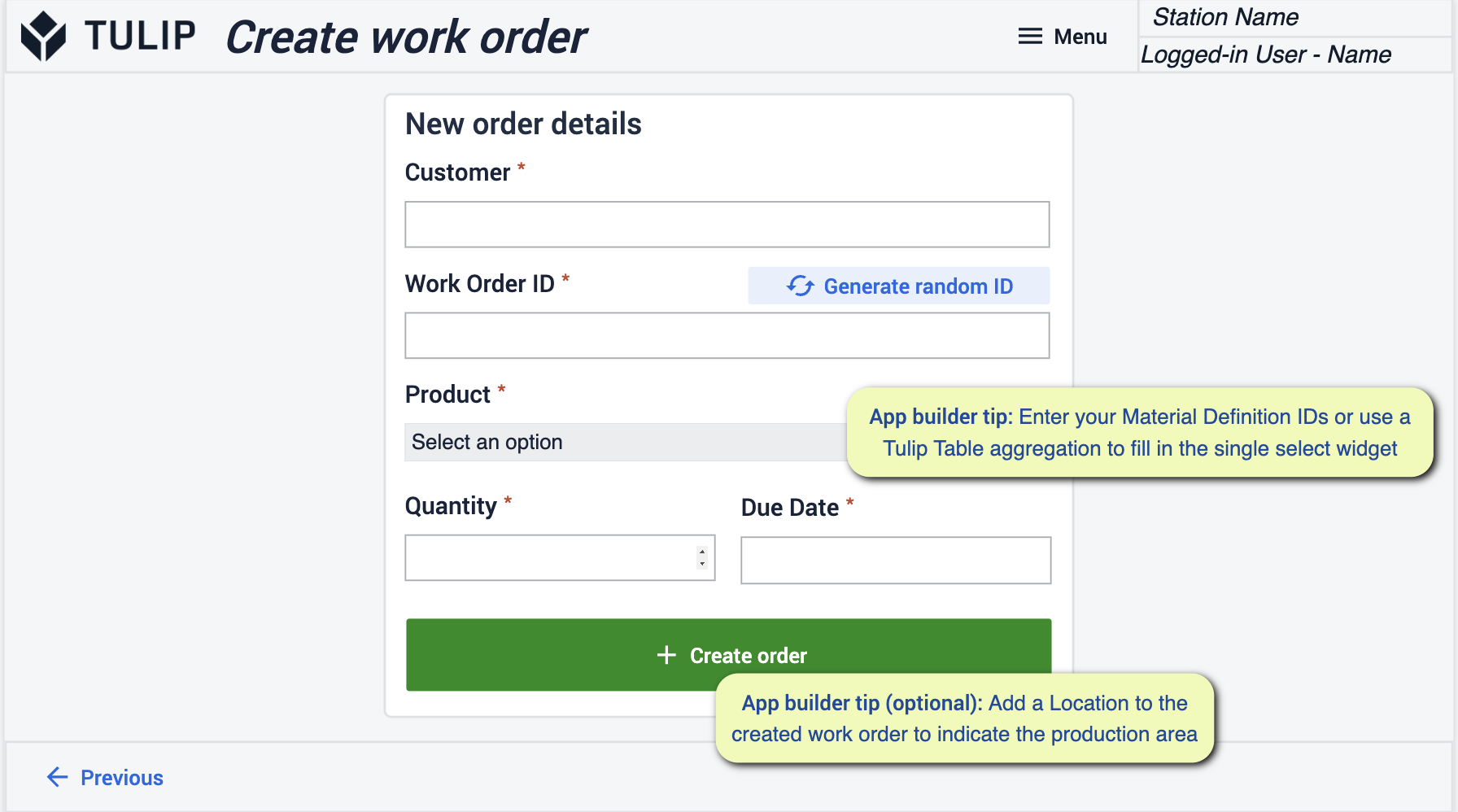 {height="300" width=""}* Ügyeljen arra, hogy adja meg az anyagazonosítókat, vagy használja a táblázat-összesítőket, hogy egyetlen kiválasztott widget segítségével töltse ki.
{height="300" width=""}* Ügyeljen arra, hogy adja meg az anyagazonosítókat, vagy használja a táblázat-összesítőket, hogy egyetlen kiválasztott widget segítségével töltse ki.
Munkamegrendelés részleteinek megtekintése
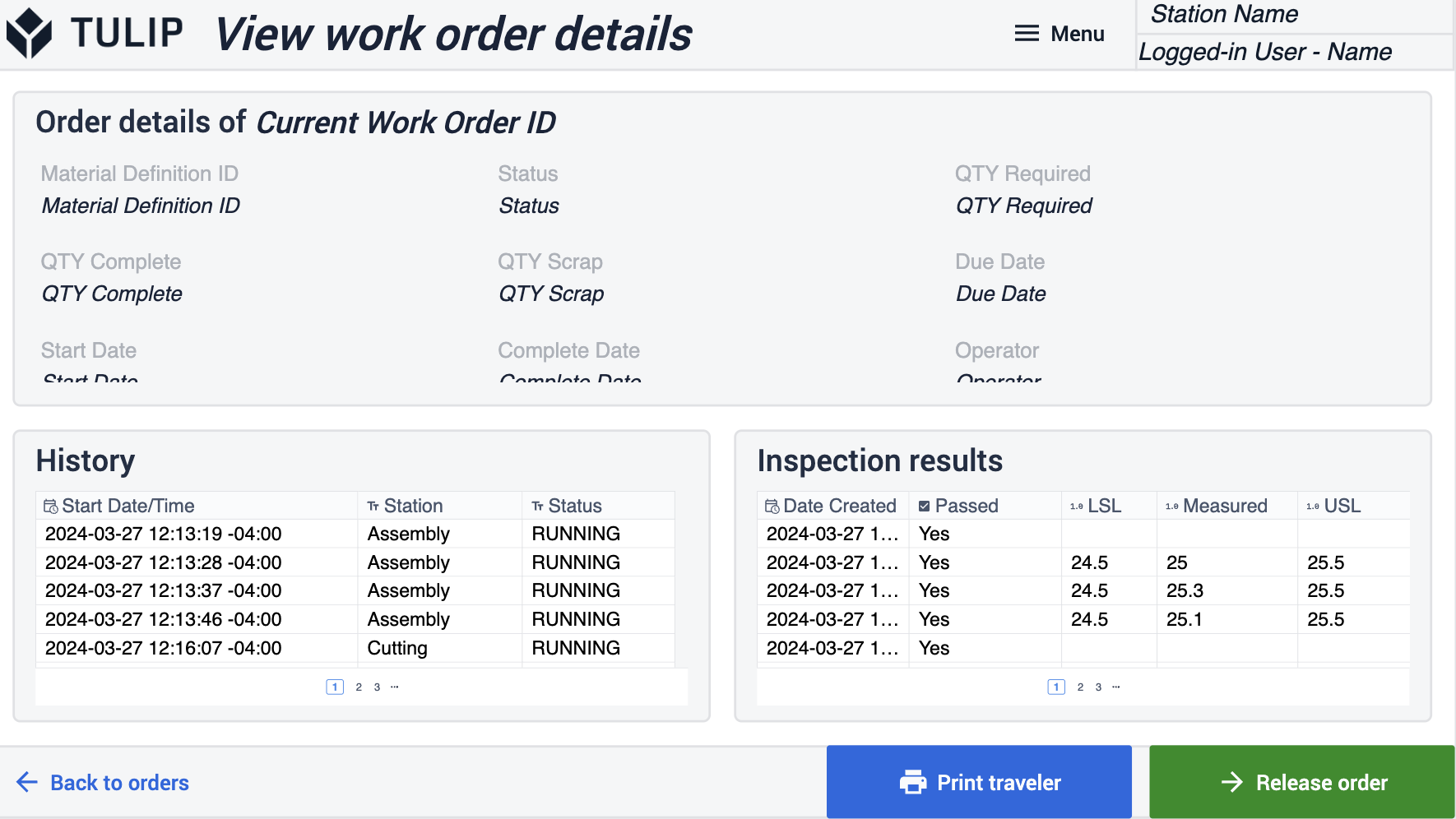 {height="300" width=""}* Ebben a lépésben az előző munkamegrendelés nézetből részletesebb részleteket tekinthet meg. Itt ki is nyomtathatja az információkat, ha szükséges.
{height="300" width=""}* Ebben a lépésben az előző munkamegrendelés nézetből részletesebb részleteket tekinthet meg. Itt ki is nyomtathatja az információkat, ha szükséges.
Kiadás megerősítése
Ez a lépés részletesen megmutatja az adott megrendelésekhez tartozó anyagokat és azt, hogy mennyit használ fel belőlük.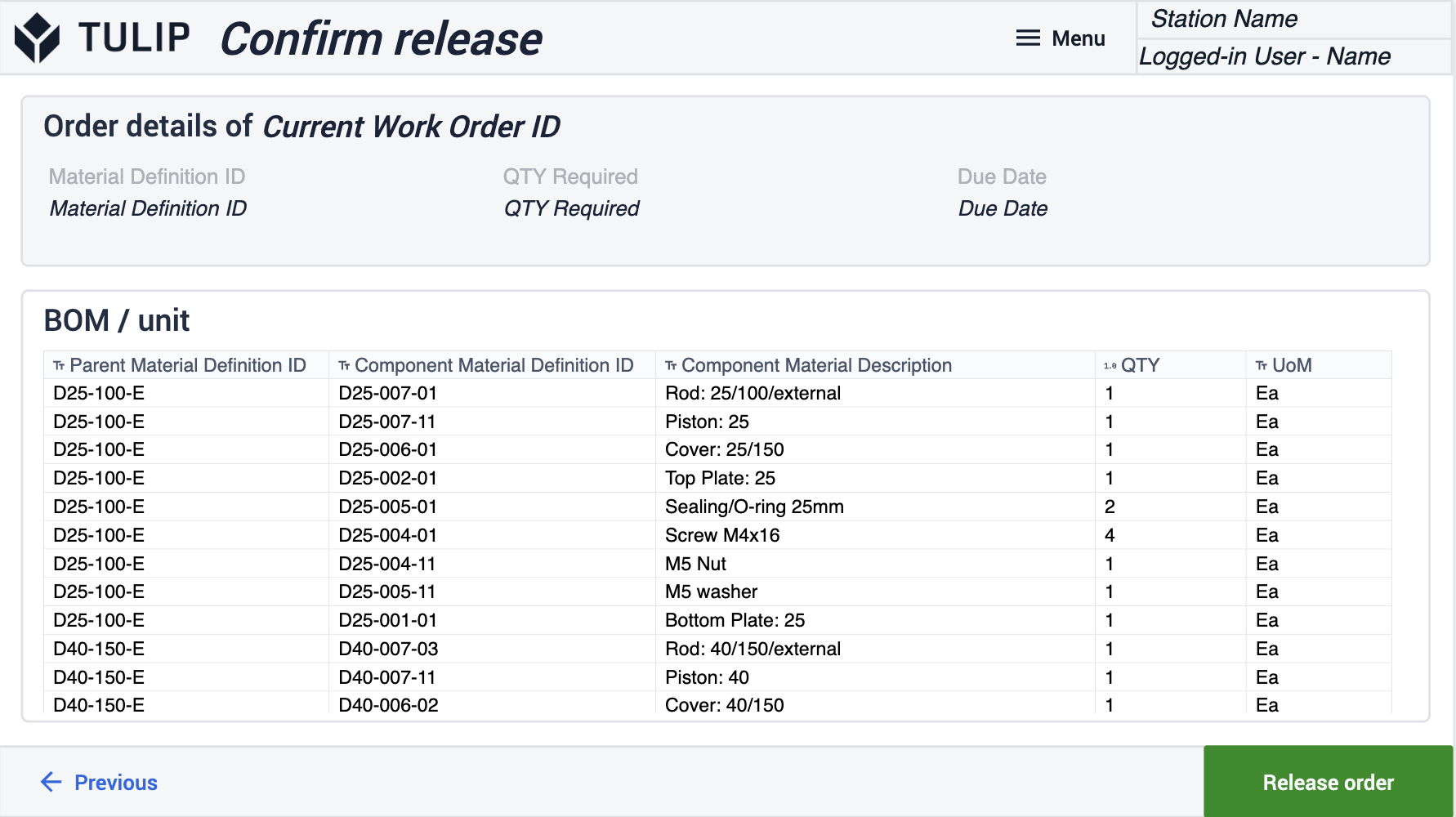
Megjegyzés hozzáadása a megrendeléshez
Adjon hozzá megjegyzéseket egy adott megrendeléshez, hogy feljegyzést hagyjon arról, hogy mi működik, miért tartott esetleg sokáig egy folyamat, és miért ment jól egy folyamat. Hagyja, hogy az operátorok gyorsan visszajelezzenek a vezetőségnek. 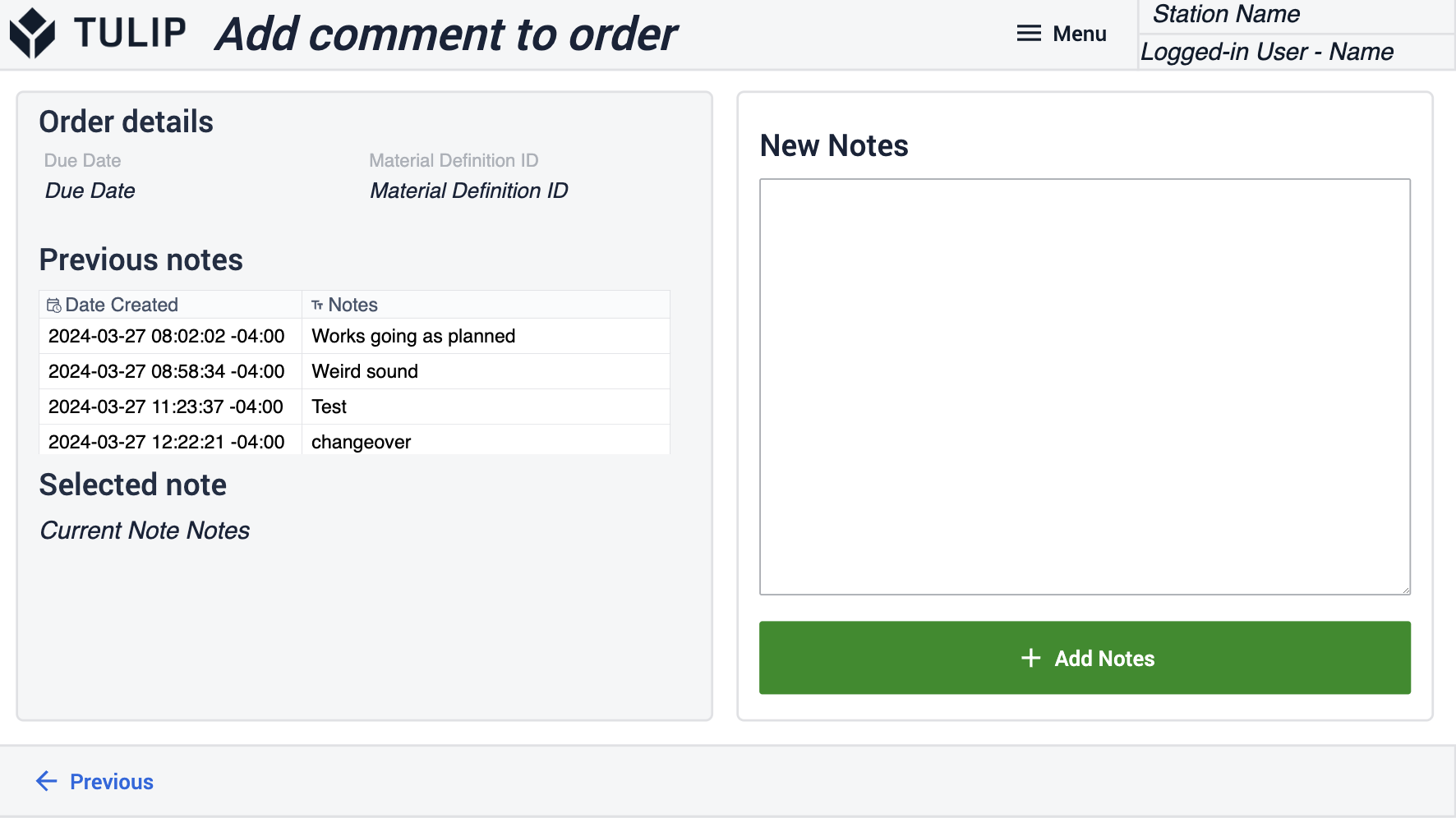
Utazó
Ez a Lépés a munkamegbízás teljes előzményei felett mutatja be. Kinek szól, mi történt vele, mikor kell elvégezni stb.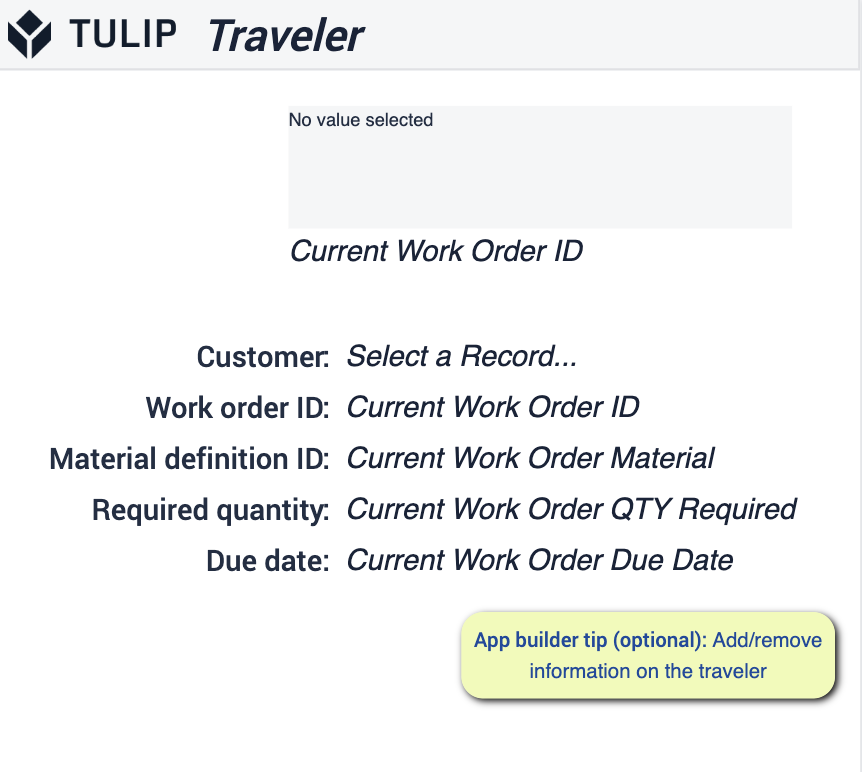 {height="300" width=""}* Hozzáadhat vagy eltávolíthat olyan információkat, amelyeket ebben a lépésben kell megjeleníteni.
{height="300" width=""}* Hozzáadhat vagy eltávolíthat olyan információkat, amelyeket ebben a lépésben kell megjeleníteni.
Tudjon meg többet a megrendeléskövetésről.
Teljesítmény láthatóság terminál{target=_blank}
Ennek az alkalmazásnak a használatával magas szintű teljesítményadatokat rögzíthet, miközben az alkatrészeket egy ember vagy egy gép gyártja. Itt a kezelők képesek lesznek naplózni a gépi tevékenység és a termelés elemzése körüli adatokat.
Megrendelés kiválasztása
Ez a lépés lehetővé teszi a gyártás megkezdéséhez szükséges munkamegrendelések kiválasztását. Tekintse meg a termelésben lévő megrendelések típusainak részleteit, valamint azt, hogy hol vannak.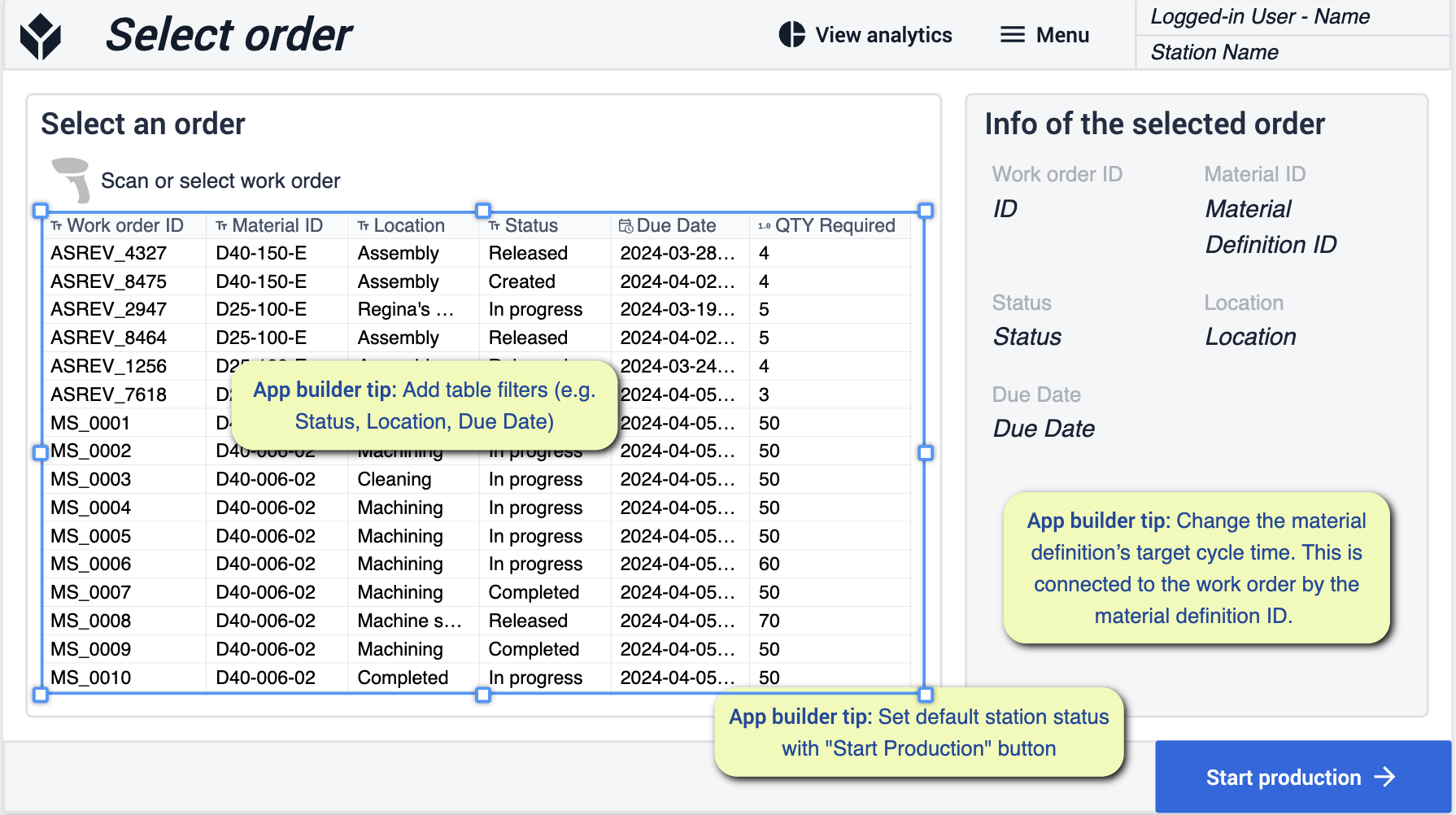 {height="300" width=""}* Az előző munkamegrendelések kiválasztásához hasonlóan, szükség szerint módosíthatja a táblázatot. Figyeljen különösen az Anyagmeghatározás és az Állomás állapota körüli változásokra.
{height="300" width=""}* Az előző munkamegrendelések kiválasztásához hasonlóan, szükség szerint módosíthatja a táblázatot. Figyeljen különösen az Anyagmeghatározás és az Állomás állapota körüli változásokra.
Főoldal
Ennek a lépésnek az a célja, hogy segítsen megjeleníteni az adott állomás állapotát, ahonnan éppen dolgozik. Valamint segít a jó és a hibás alkatrészek rögzítésében. {height="300" width=""}* Ügyeljen arra, hogy kövesse a felcímkézett lépéseket a megfelelő állomásállapotok megjelenítéséhez.
{height="300" width=""}* Ügyeljen arra, hogy kövesse a felcímkézett lépéseket a megfelelő állomásállapotok megjelenítéséhez.
Állapot módosítása lefelé
Kiválaszthatja a leállási okokat az alapján, hogy egy gép miért állt le. Állítsa be azokat az okokat, amelyeknek a működése szempontjából értelme van.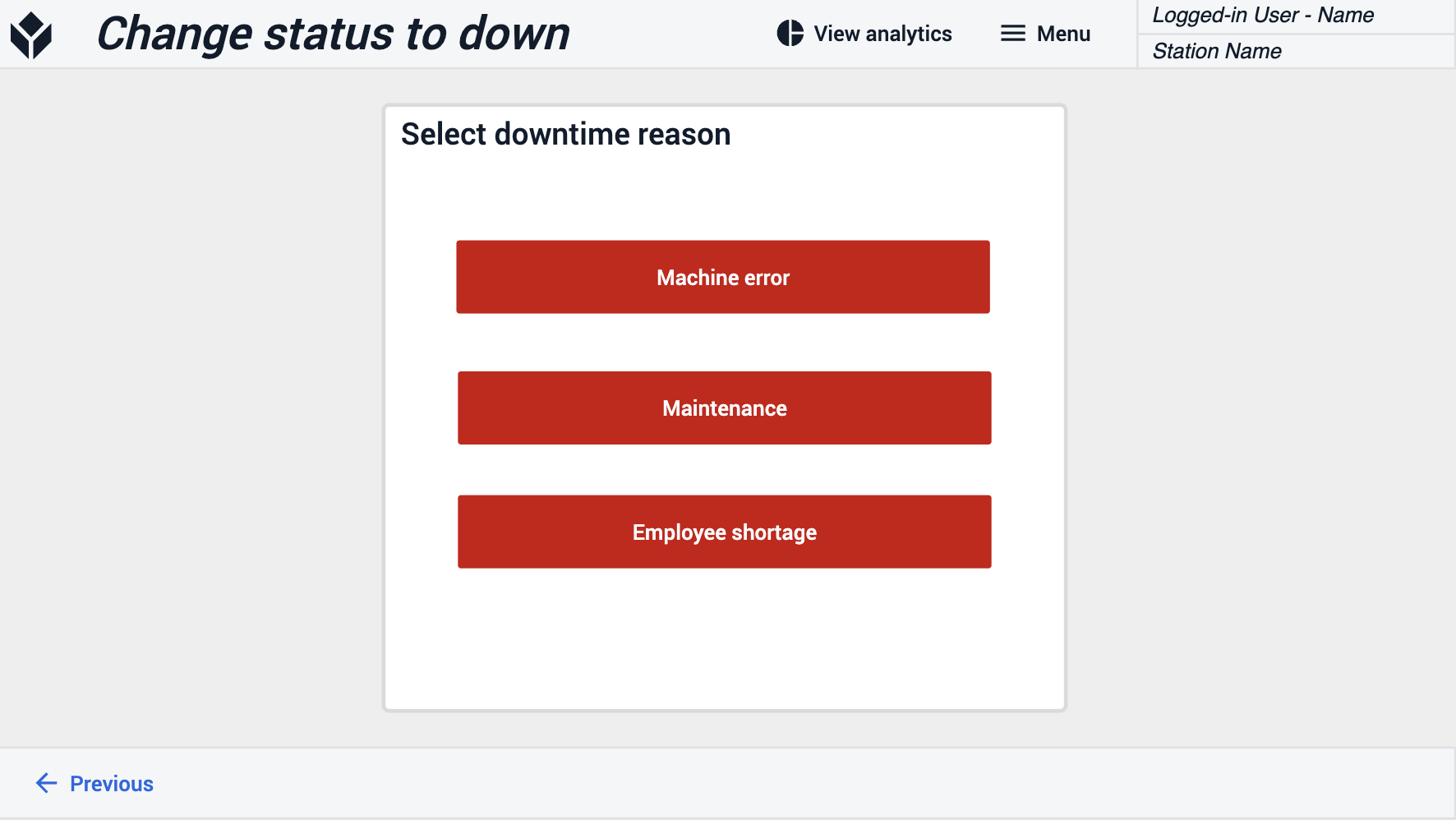
Analitika
Részletes információkat láthat a gépek teljesítményéről az adott napra vagy hétre vonatkozóan. {height="300" width=""}* Ha szeretne még többféle nézetet, bármikor hozzáadhat továbbiakat a könyvtárból.
{height="300" width=""}* Ha szeretne még többféle nézetet, bármikor hozzáadhat továbbiakat a könyvtárból.
Andon terminál
Az Andon alkalmazás lehetővé teszi a nyitott megbízások megtekintését és kiválasztását, a megbízások végrehajtását és szükség esetén leállási események létrehozását. Miután egy megbízás végrehajtásra került, azt lezártnak lehet jelölni.
Megbízás kiválasztása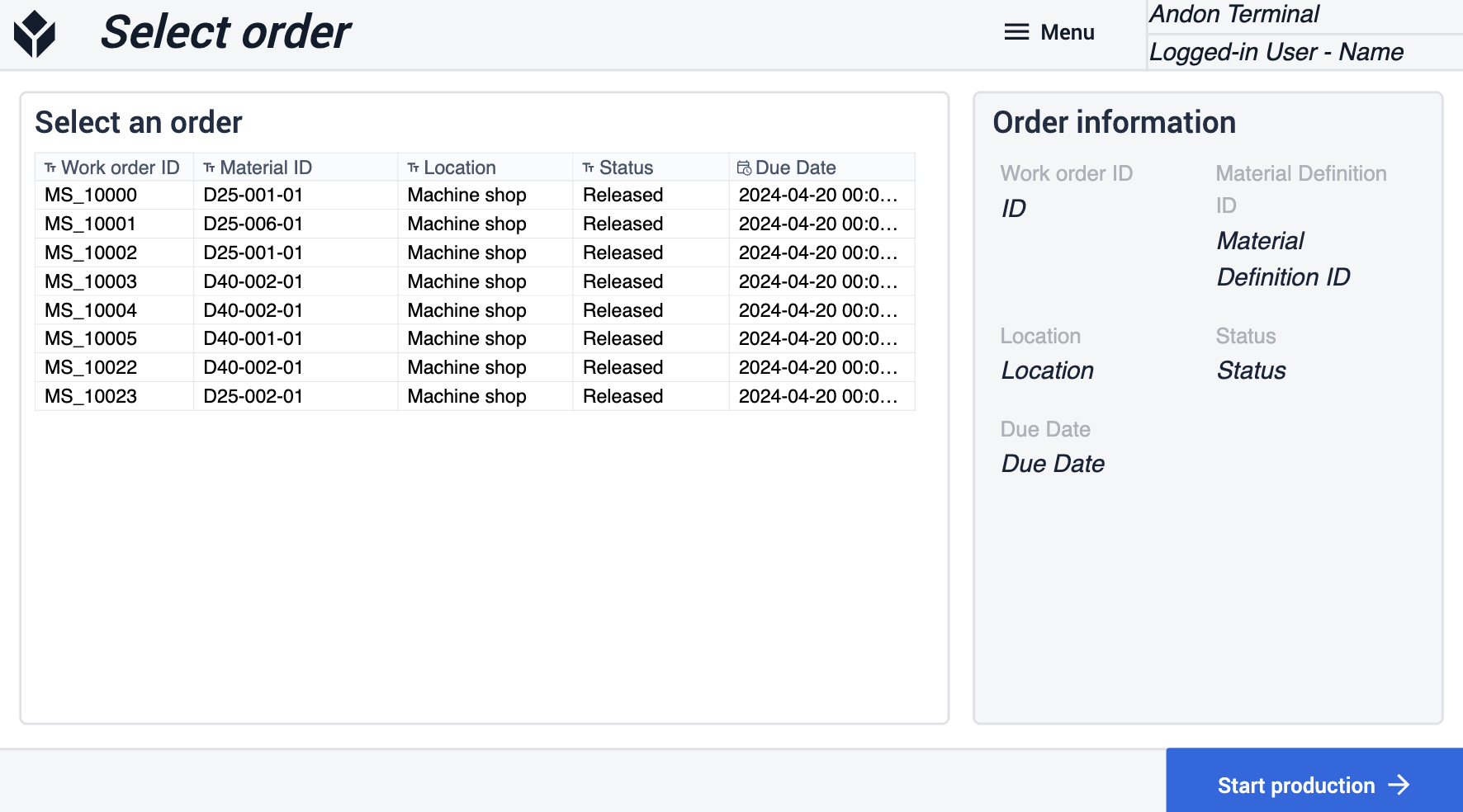
Főoldal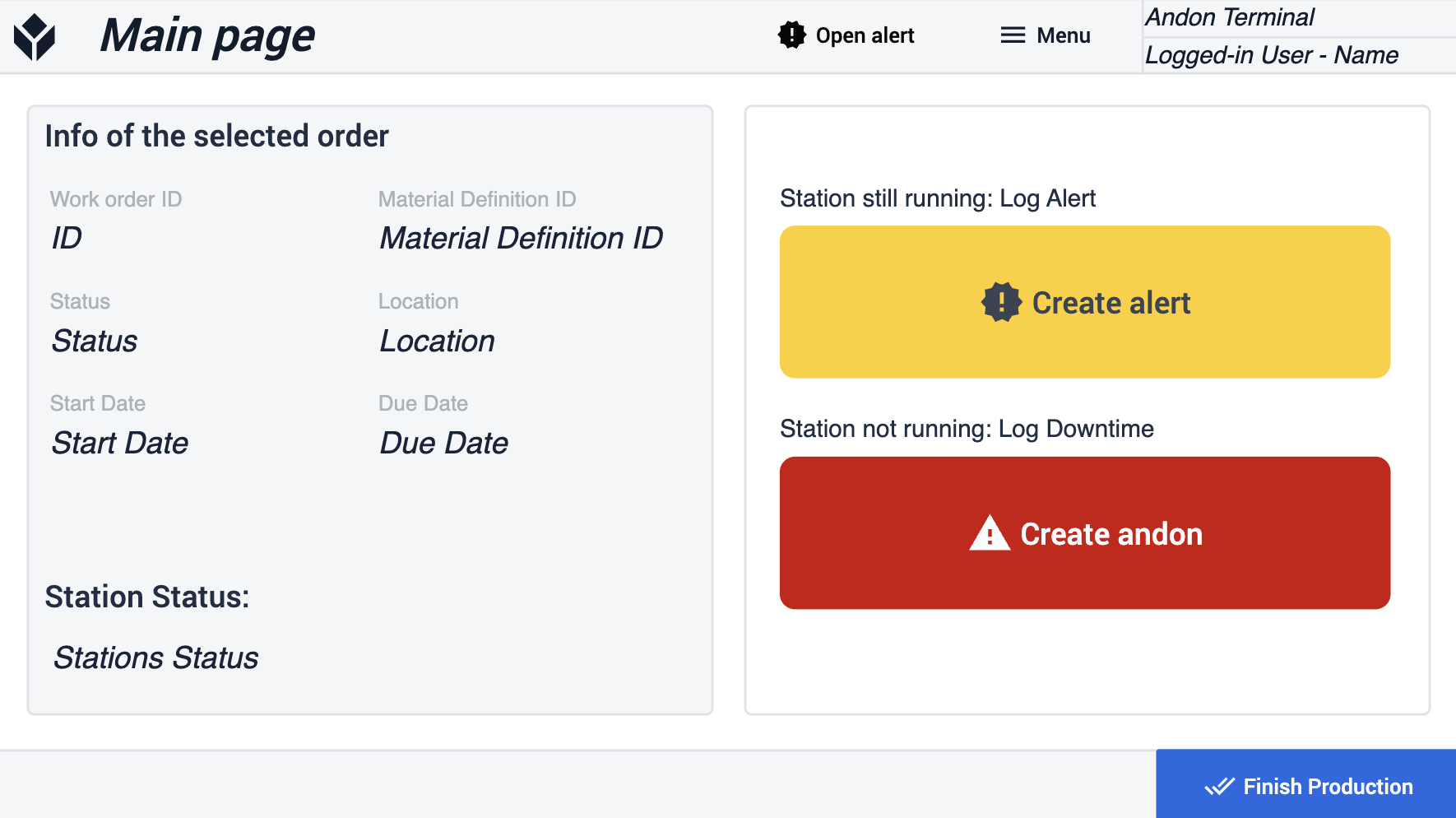
Andon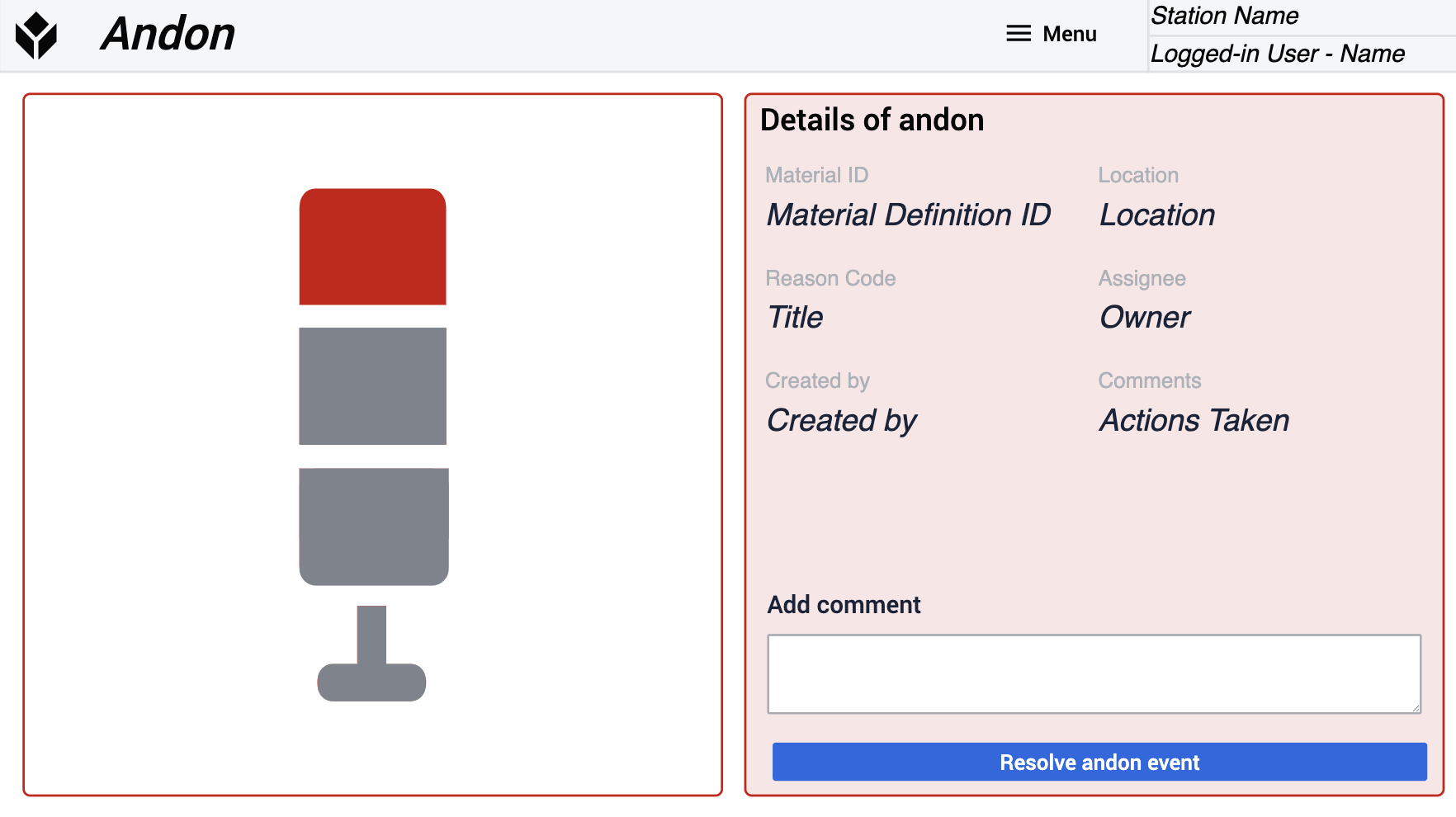 {height="300" width="""}
{height="300" width="""}
Create Andon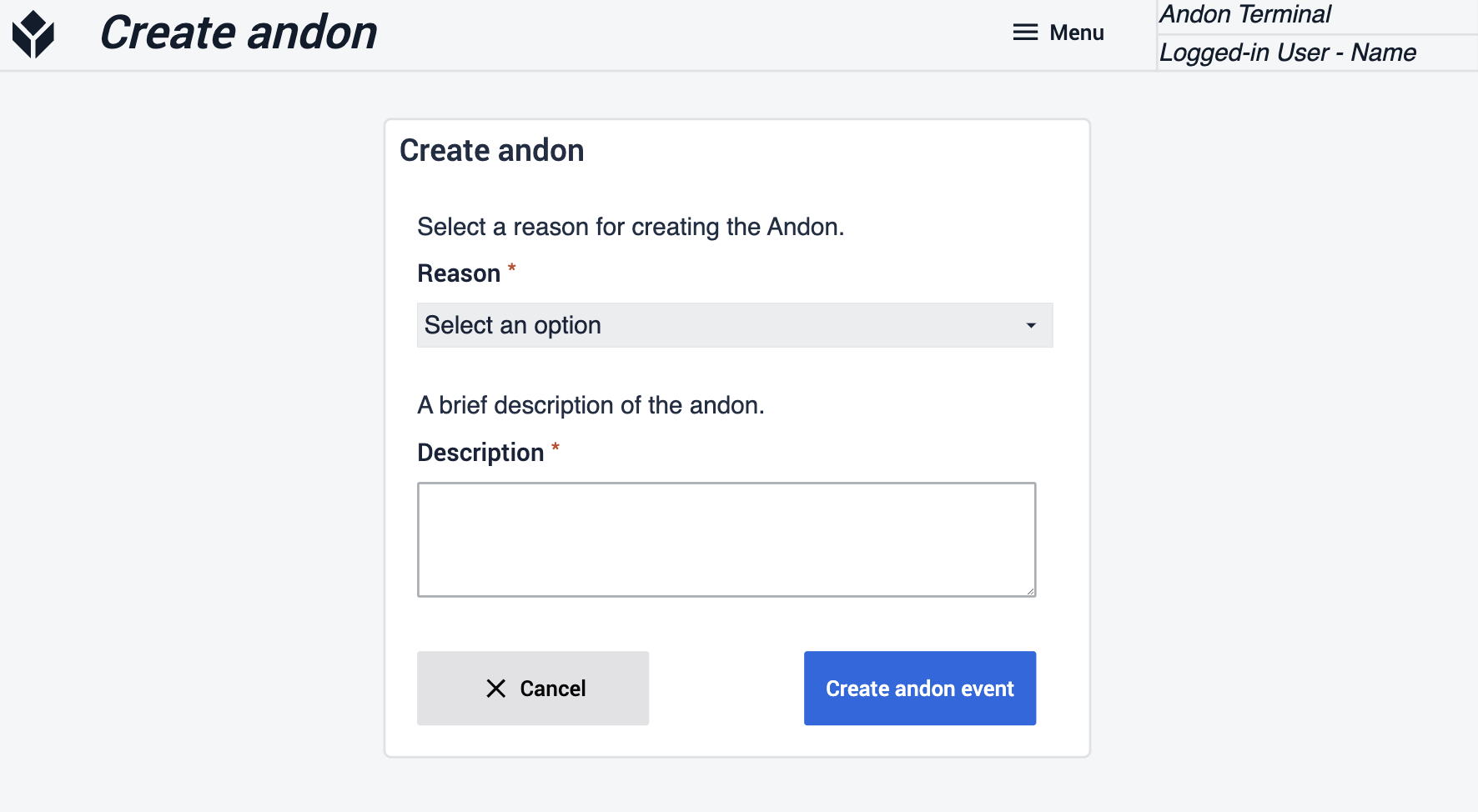 {height="300" width="""}
{height="300" width="""}
Open Alert Event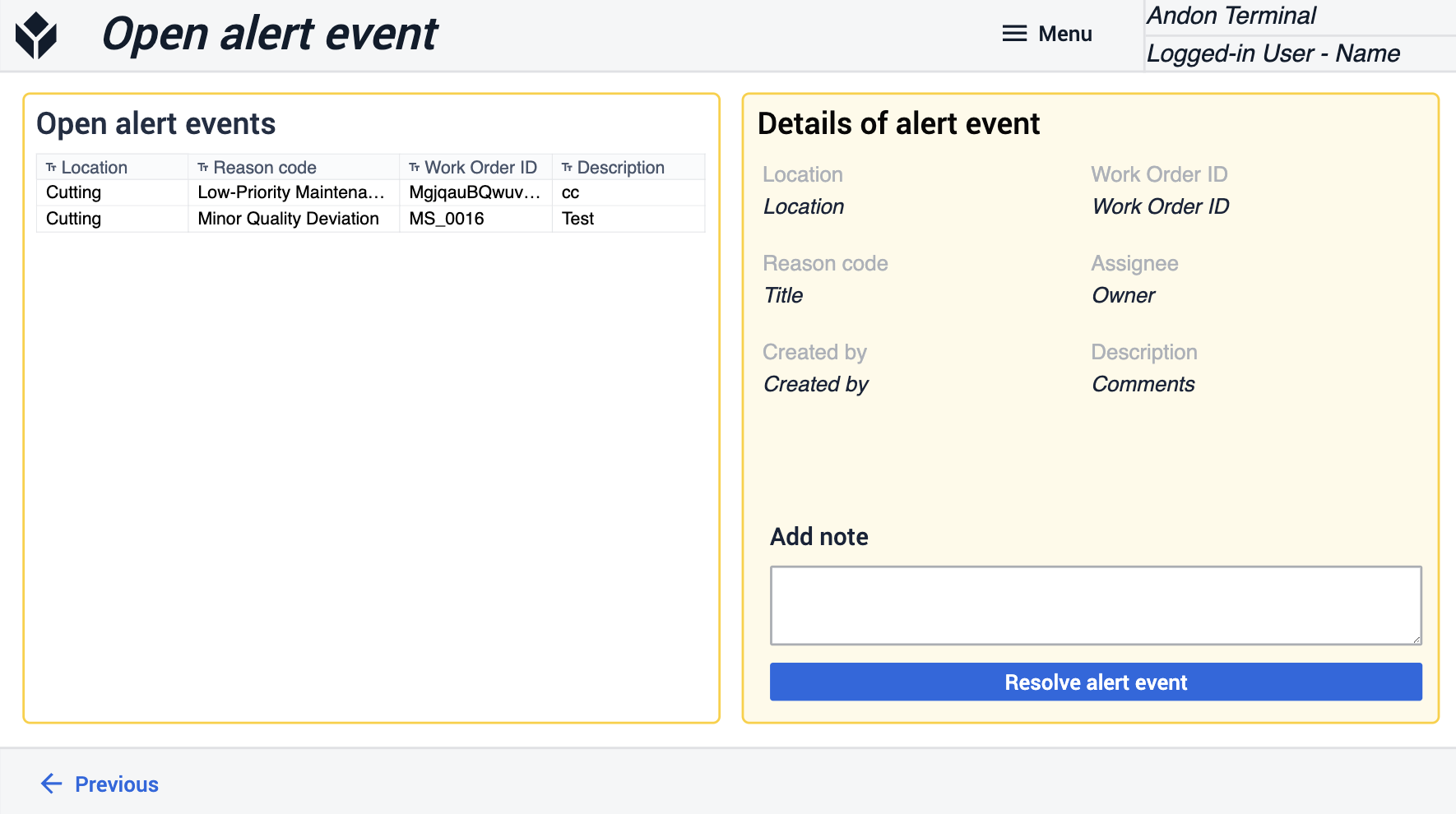 {height="300" width="""}
{height="300" width="""}
Performance Visibility Dashboard
Ez az irányítópult az emeleten rögzített adatok felügyeletére szolgál. Maximalizálja a rendelkezésre állási időt az első lépés hozamának , a ciklusidőnek és a Pareto-grafikonoknak a nyomon követésével.
Műveletirányítási műszerfal
Ennek az alkalmazásnak a célja, hogy mélyebb betekintést nyújtson az olyan kulcsfontosságú mérőszámokba, mint a teljesítmény, a minőség, a biztonság és a rendelkezésre állás. Sokkal több betekintést nyerhet a műveletekbe.
Dashboard
Itt egy műszerfali nézetet kap néhány kulcsfontosságú padlómetrikus adatot. A szilárd mérőszámok birtokában olyan területekre összpontosíthat, amelyek nagyobb figyelmet igényelnek. 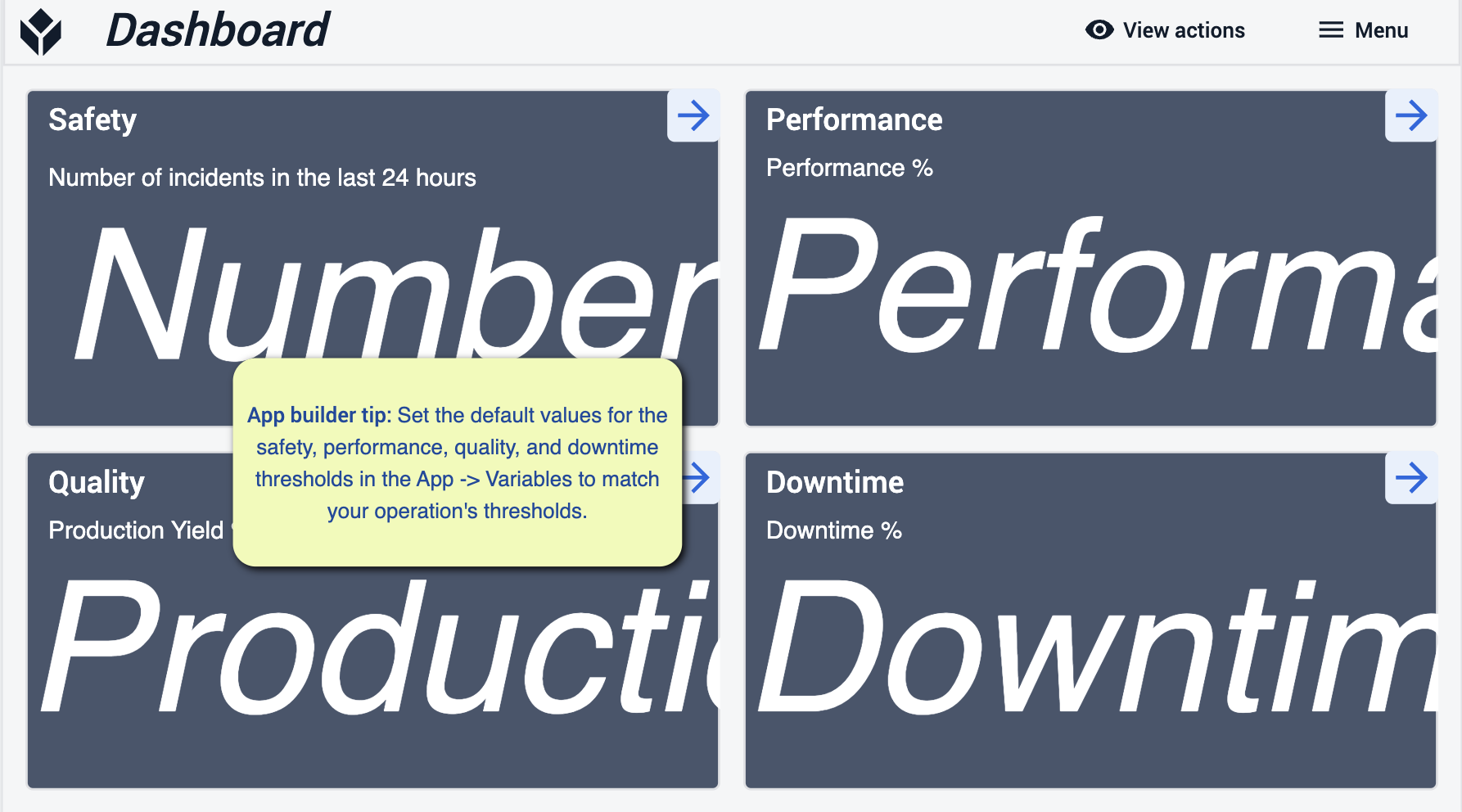
Győződjön meg róla, hogy az összes mérőszám alapértelmezett értékeit úgy állítja be, hogy azok megfeleljenek az Ön működésének.
Létrehozás
Itt hozzon létre egy új rekordot a leállási okokkal kapcsolatos tevékenységekhez, hogy nyomon követhesse az új problémák beérkezését.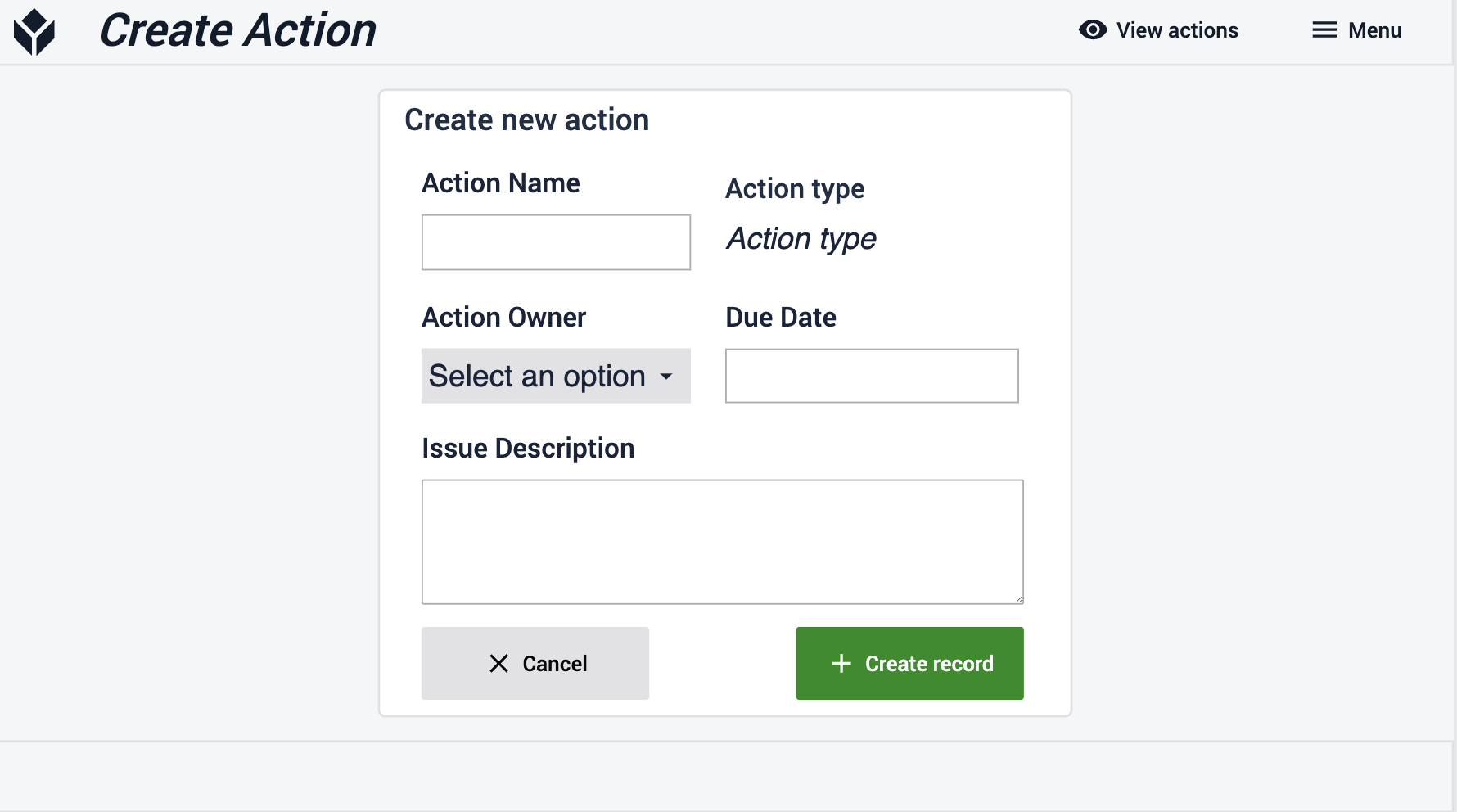
Műveletek megtekintése
Itt láthatja a nyitott és lezárt műveleteket, így mindig áttekintheti, hogy honnan érkeznek ezek a feladatok.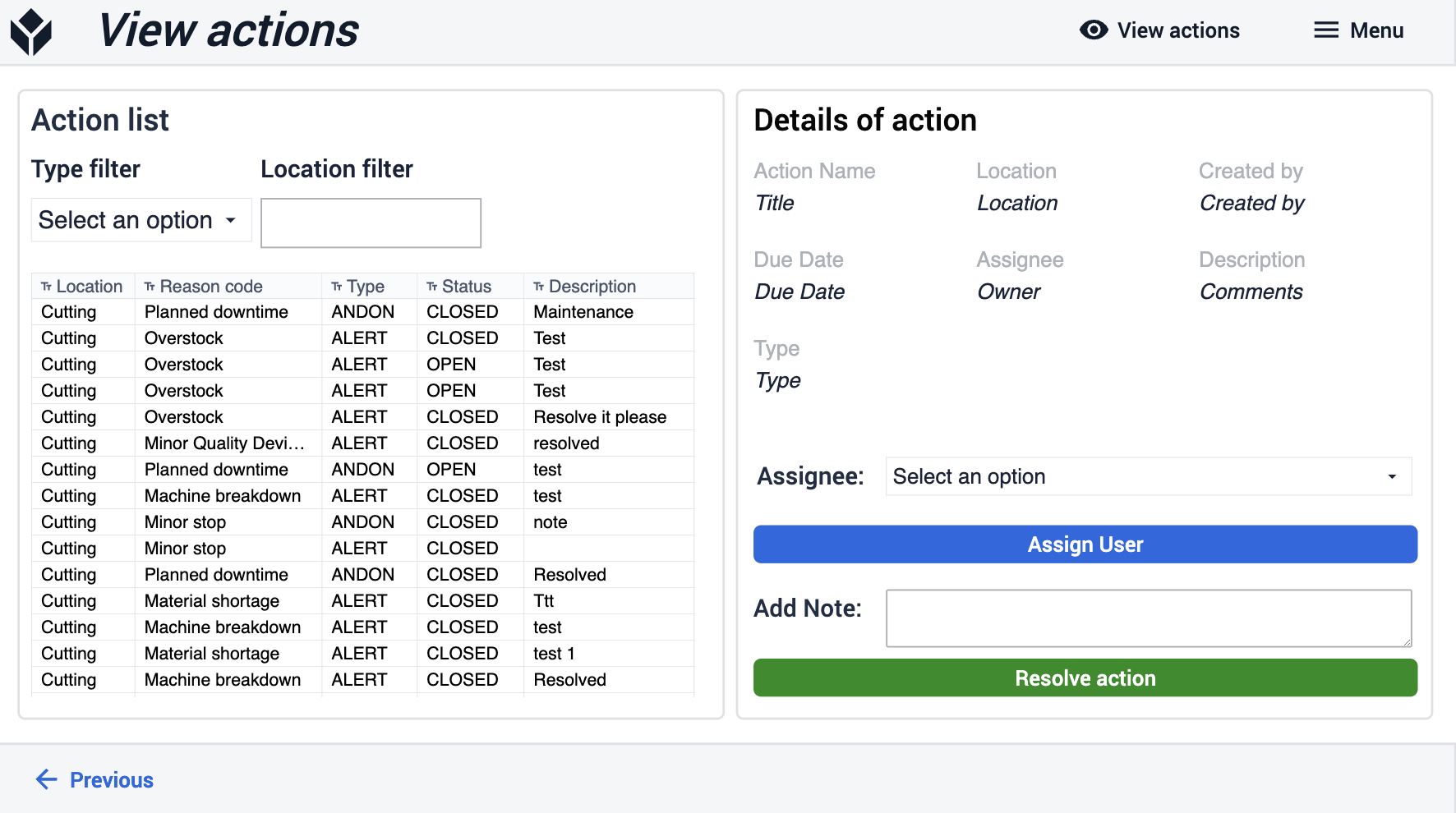
Felülvizsgálat és szállítás
A Felülvizsgálat és szállítás alkalmazás lehetővé teszi a végtermékek felülvizsgálatának feldolgozását és szállításának jóváhagyását. Ez az alkalmazás átláthatóságot biztosít a munkamegrendelés részleteihez és a szállítási részletek kezeléséhez, mint például a végső felülvizsgálati és címkefeldolgozás. A Review and Ship alkalmazás a Production Management App Suite többi alkalmazásával együtt működik.
Munkamegrendelések megtekintése
Tekintse meg a munkamegrendeléseket, mielőtt elküldi őket. Betekintést nyerhet a megrendelés előzményeibe a gyártás során. 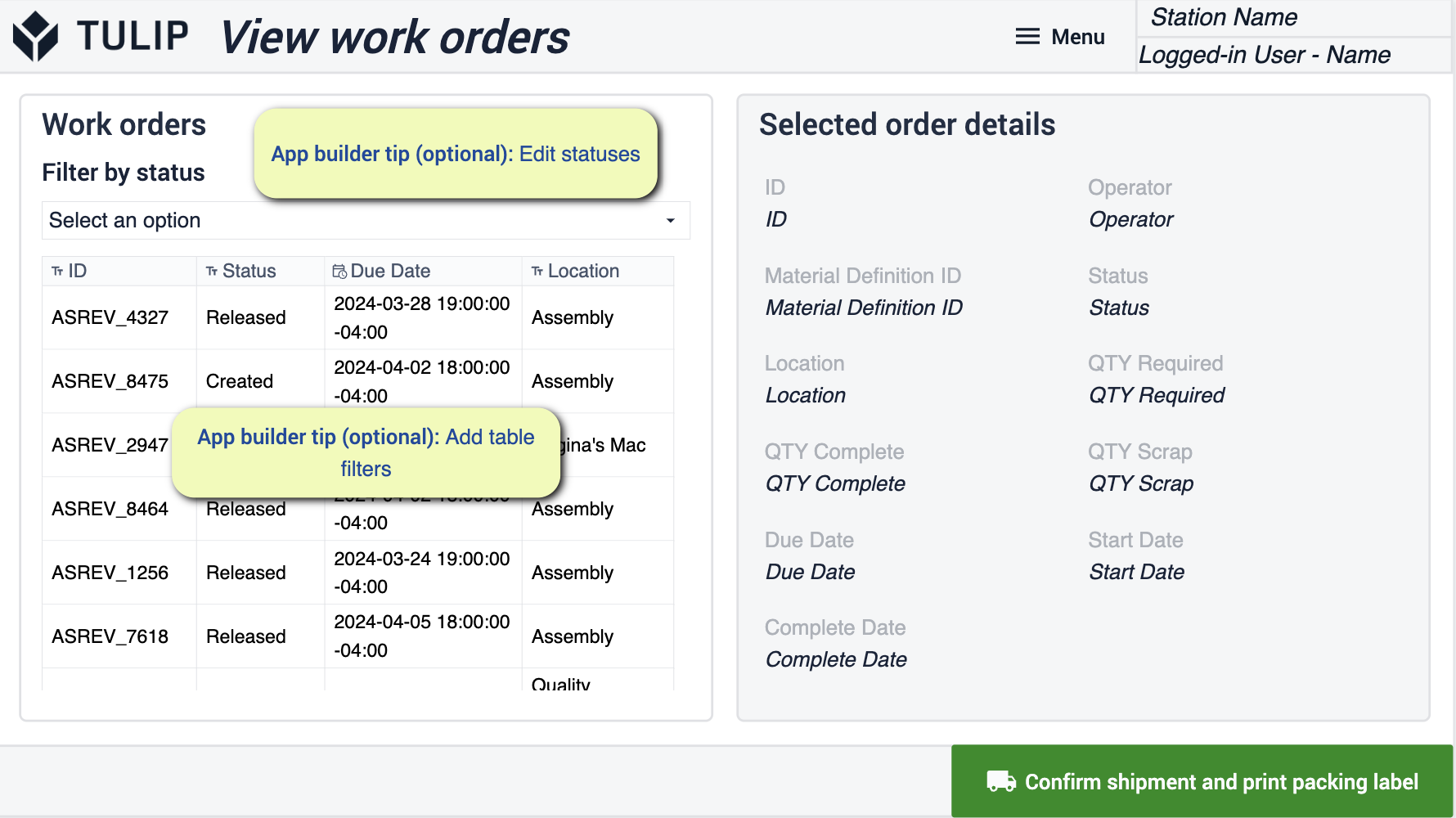
- Ennek a lépésnek a választható módosításai a táblázatszűrők és állapotok megváltoztatására összpontosítanak.
Csomagolási címke
Kiválaszthatja a szállításra kész munkamegrendeléseket. Nyomtassa ki a megfelelő címkéket, hogy az előzményeket az indulás után is nyomon követhesse.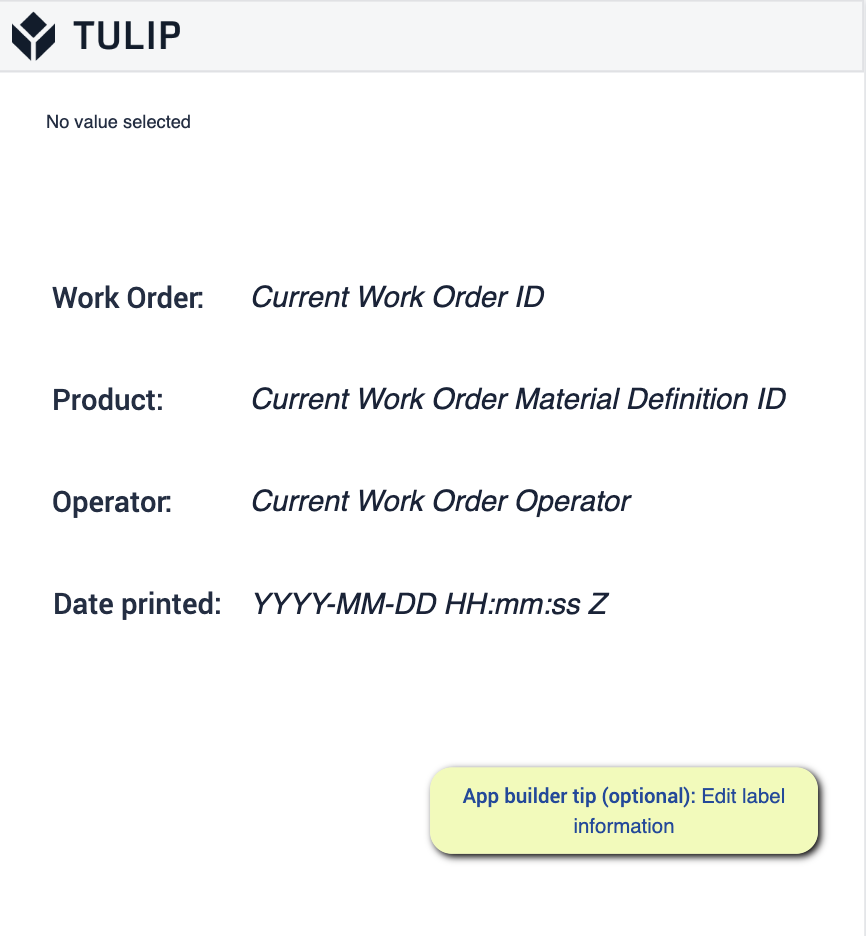
Készenlét
Az alkalmazáscsomag átnézésekor fontos, hogy kövesse az alkalmazáskészítő tippjeit. Ezek a tippek lesznek az útmutatói az alkalmazások telepítésre való felkészítéséhez. Fontos lesz, hogy hivatkozzon az előfeltételekre, és győződjön meg arról, hogy minden egyes lépésen belül követte mind a szükséges lépéseket, mind az App Builder tippjeit.